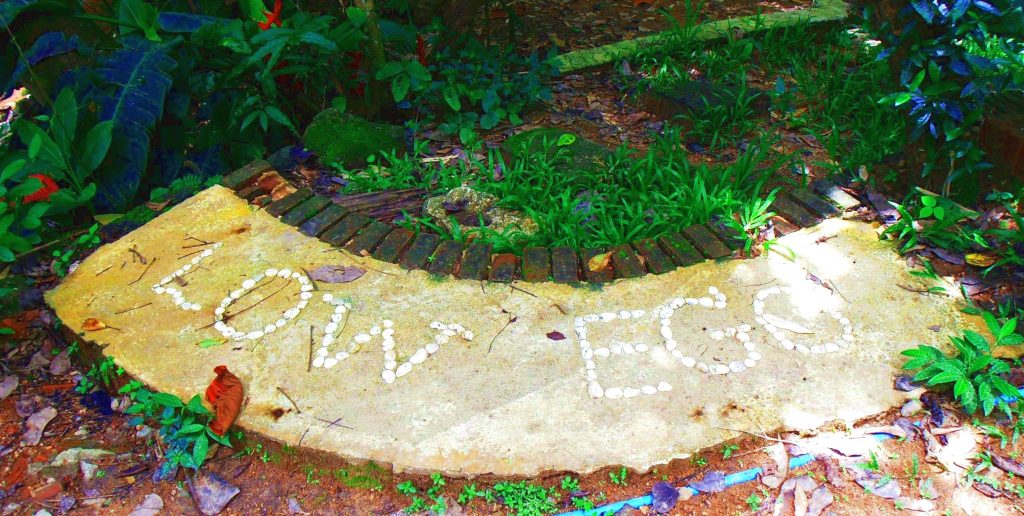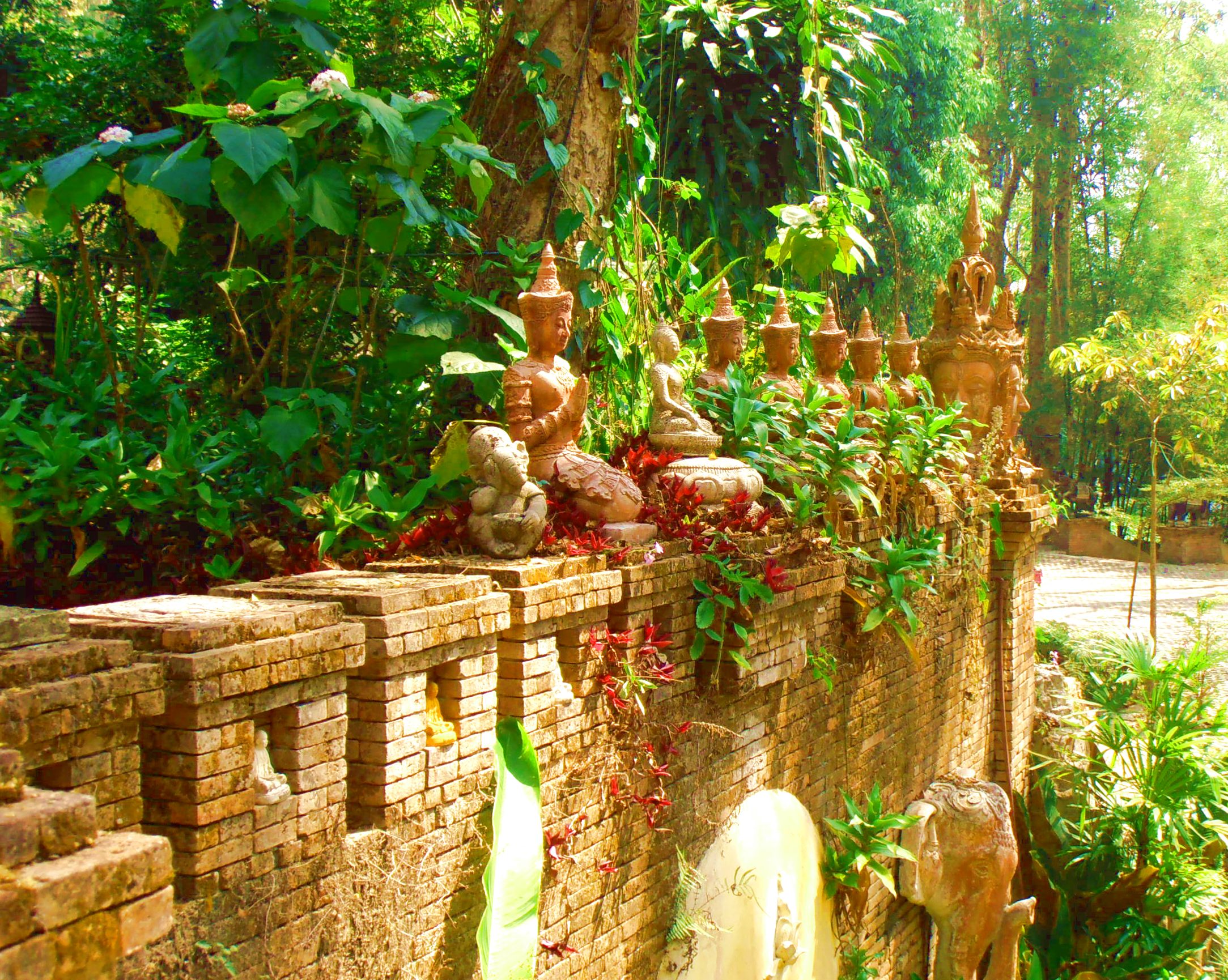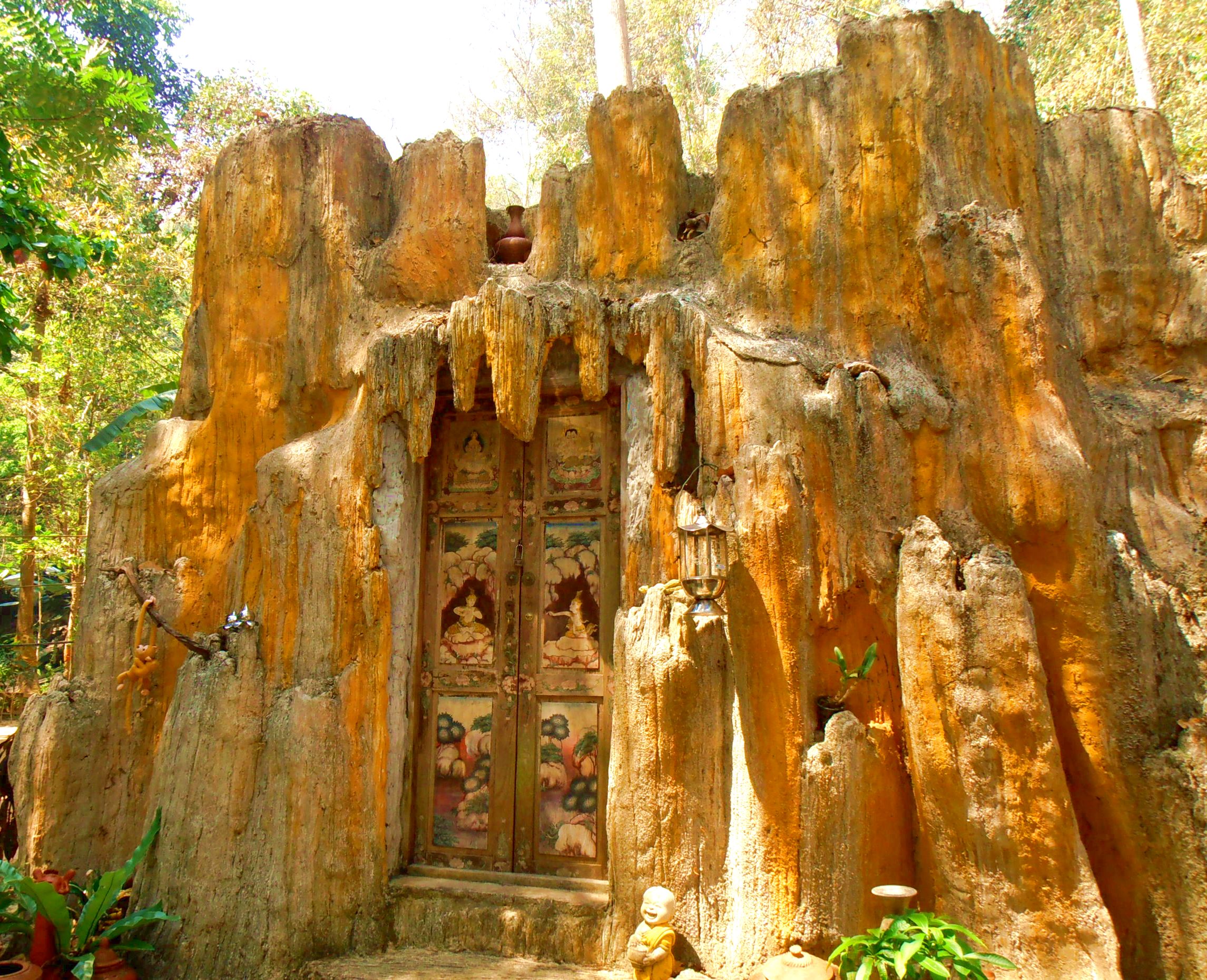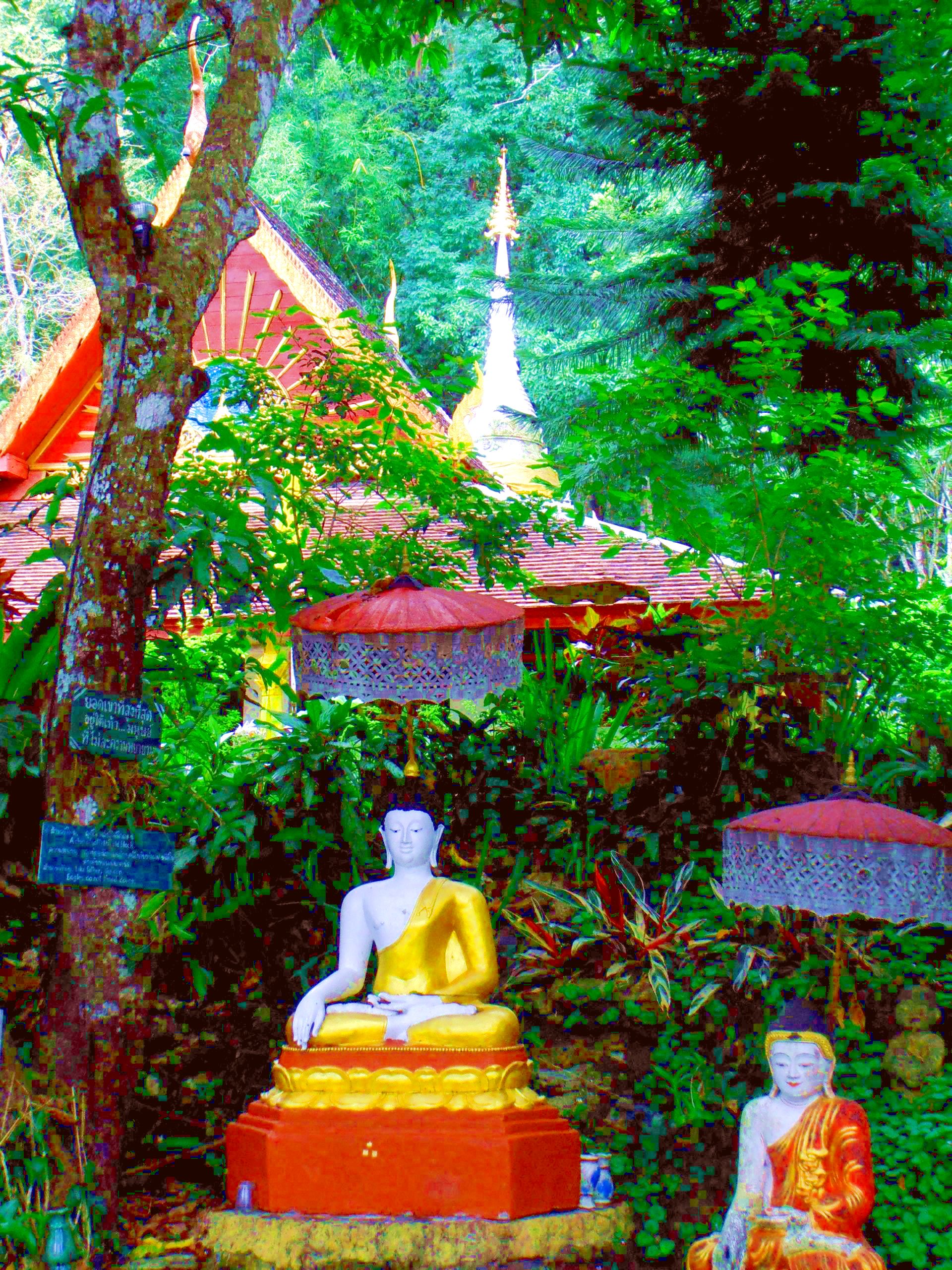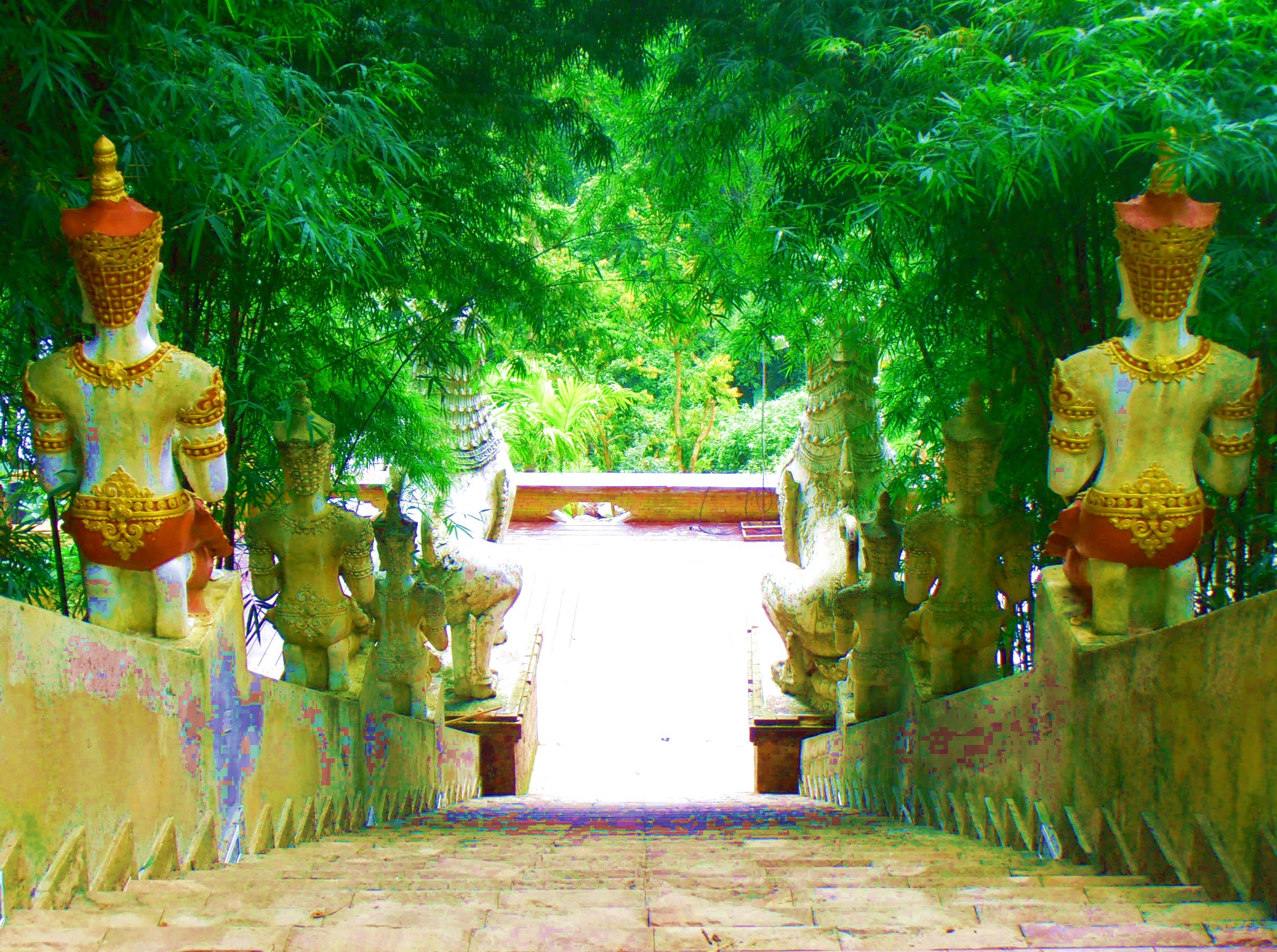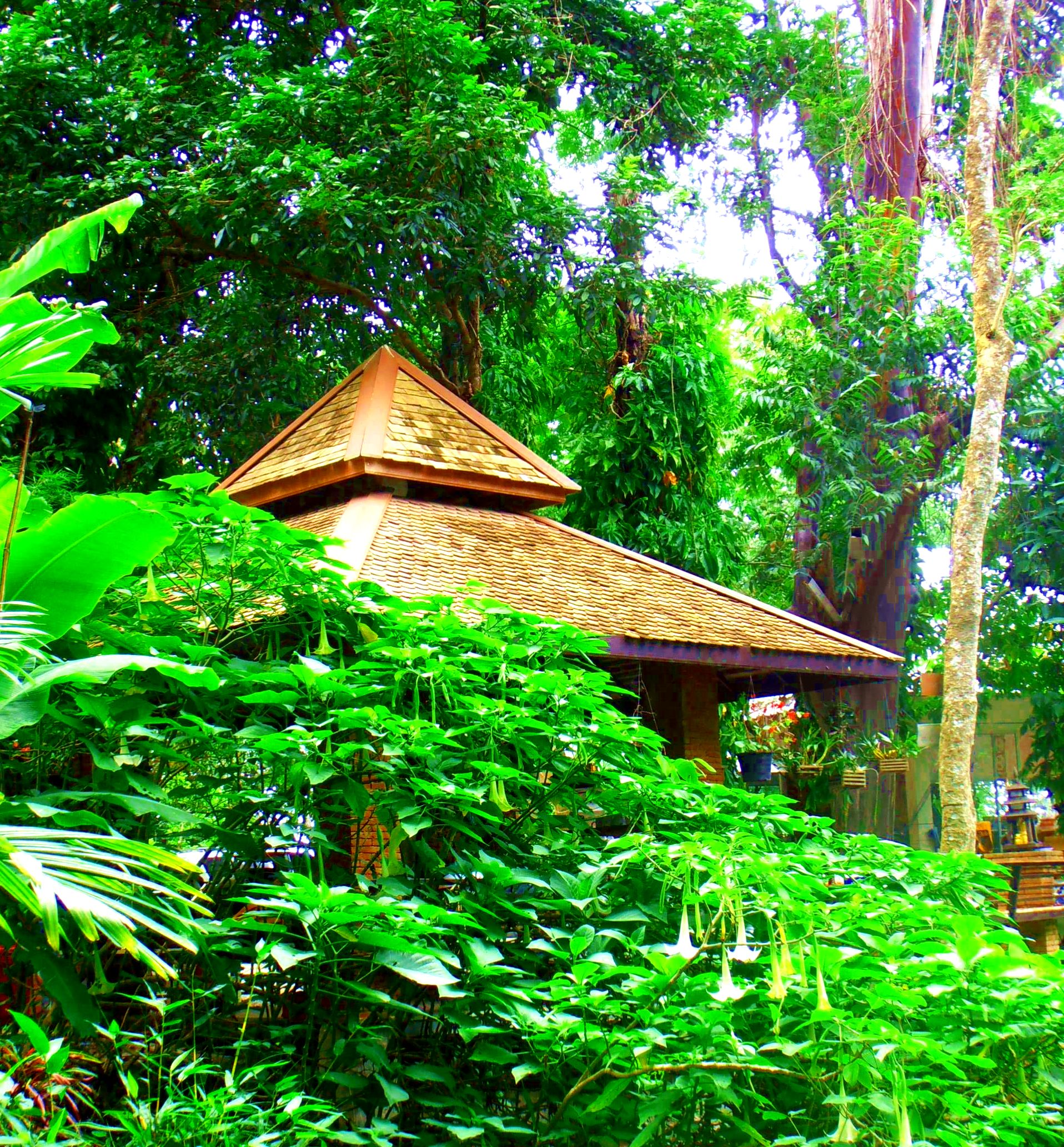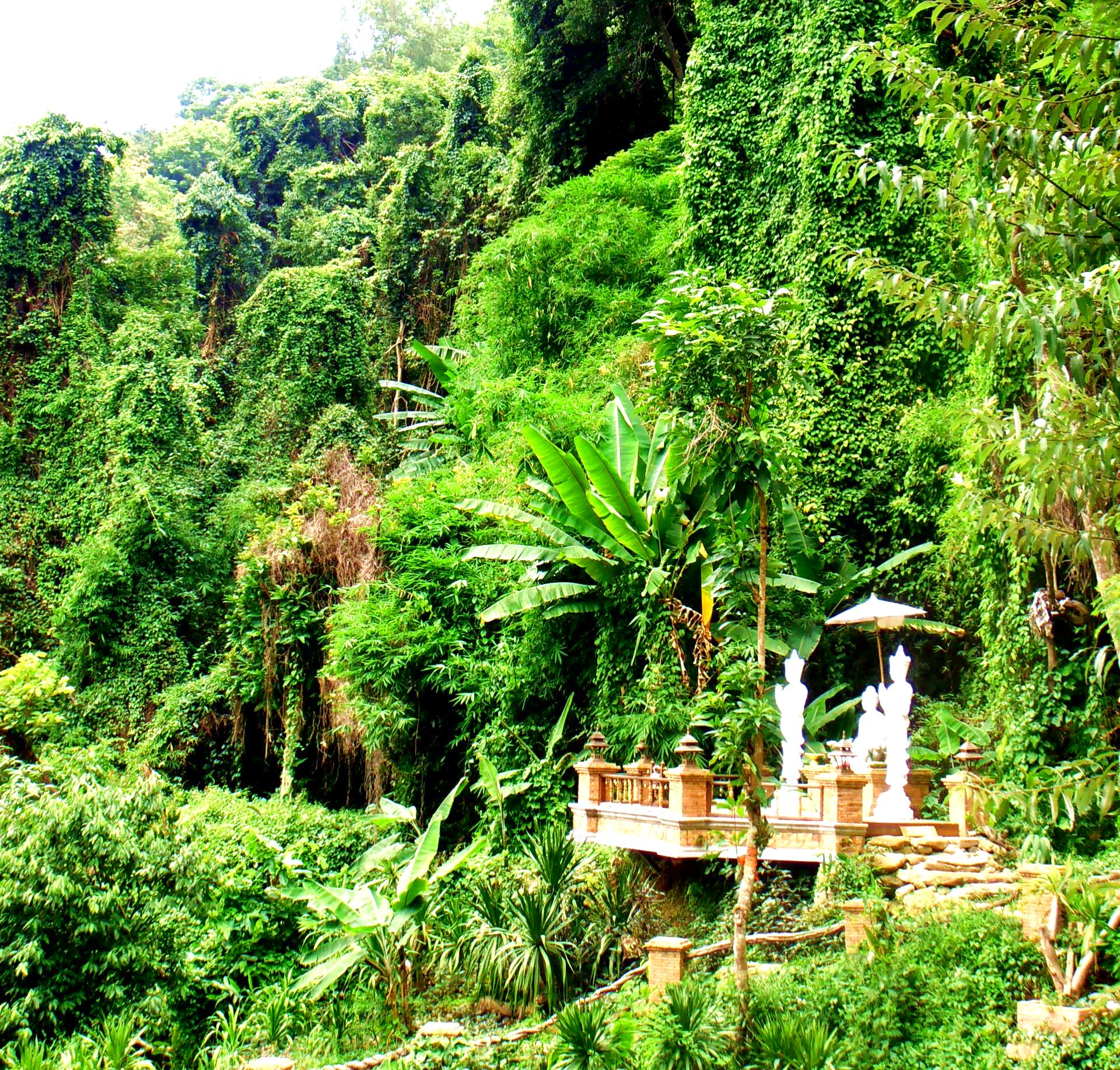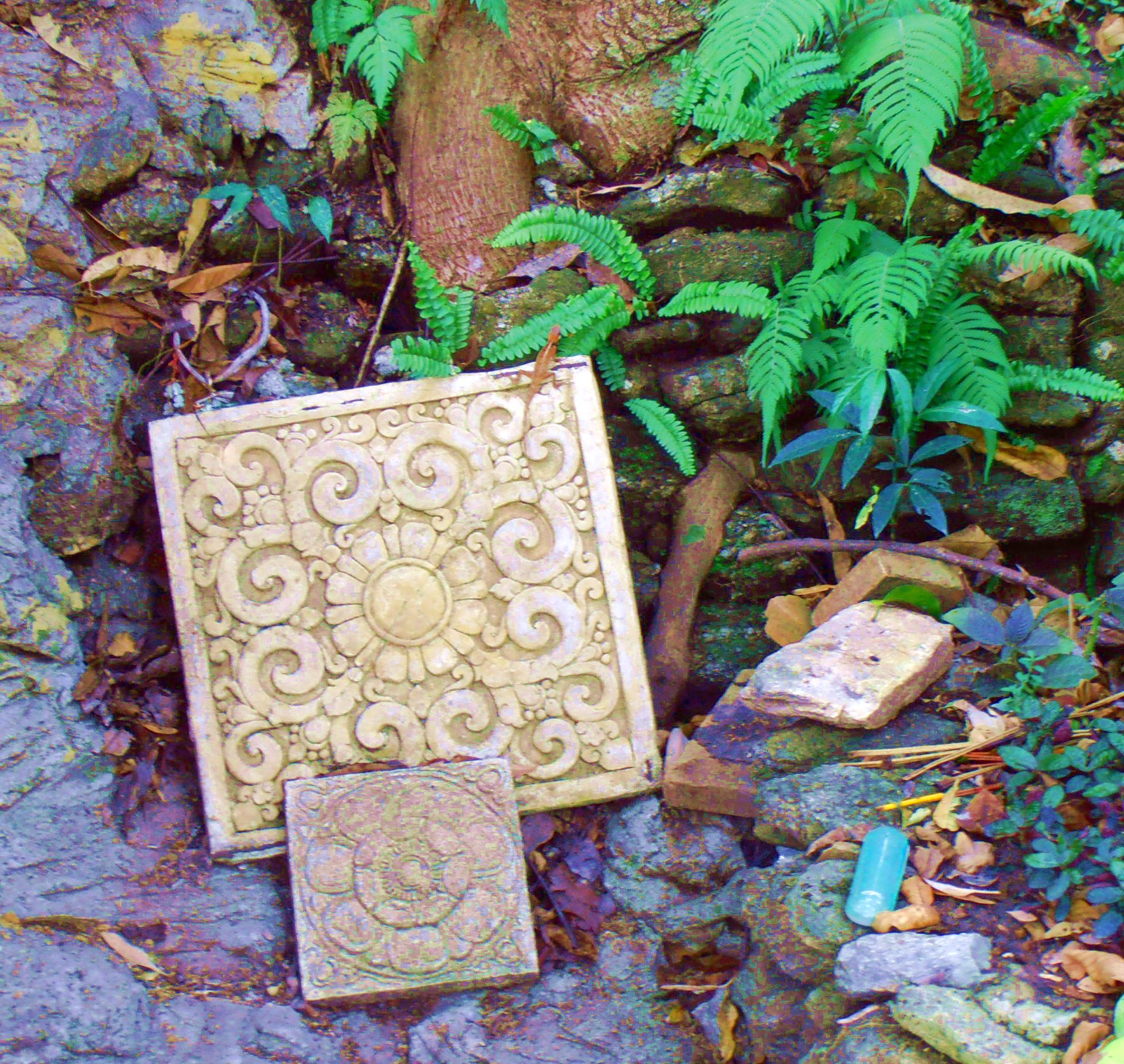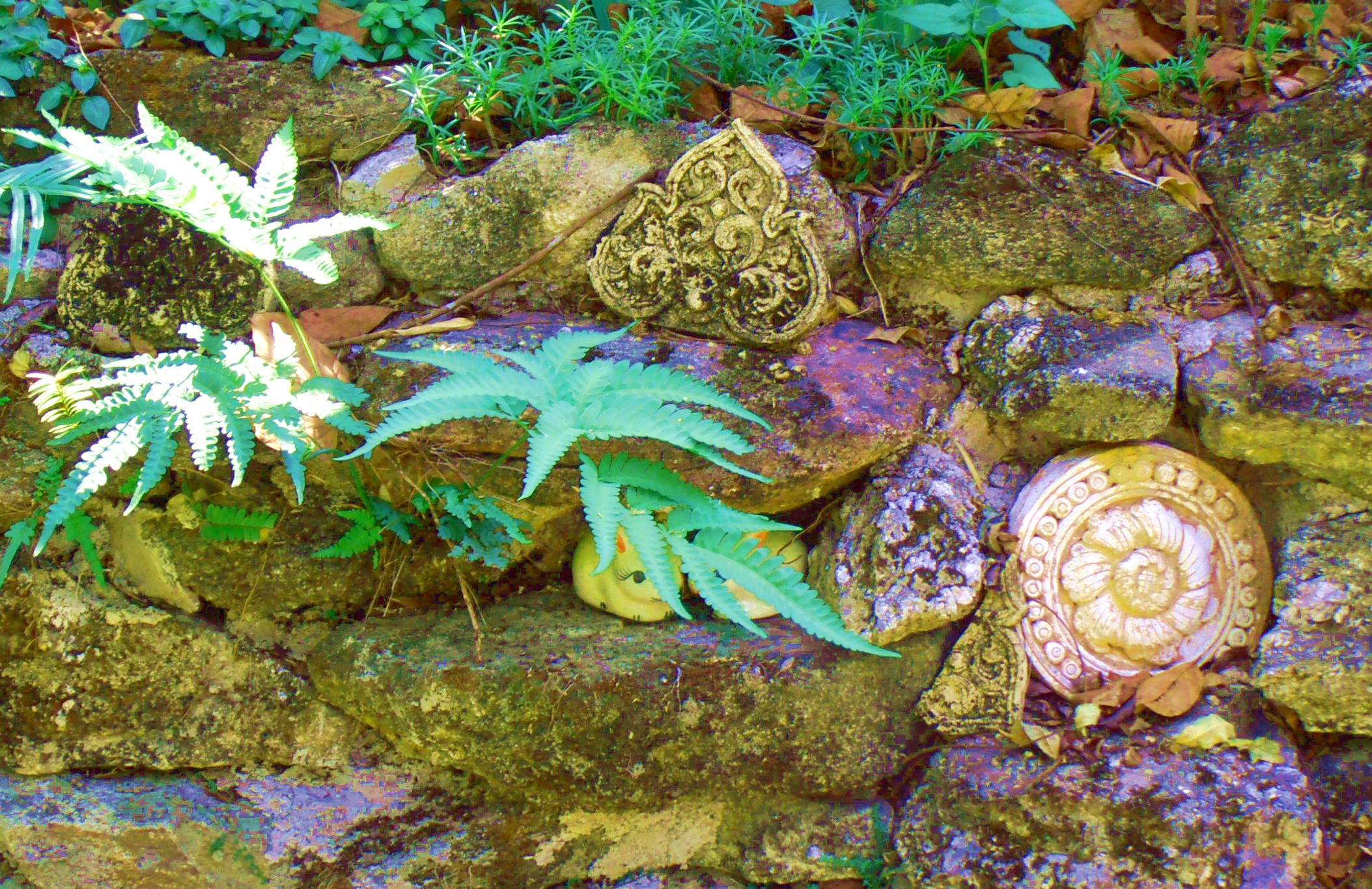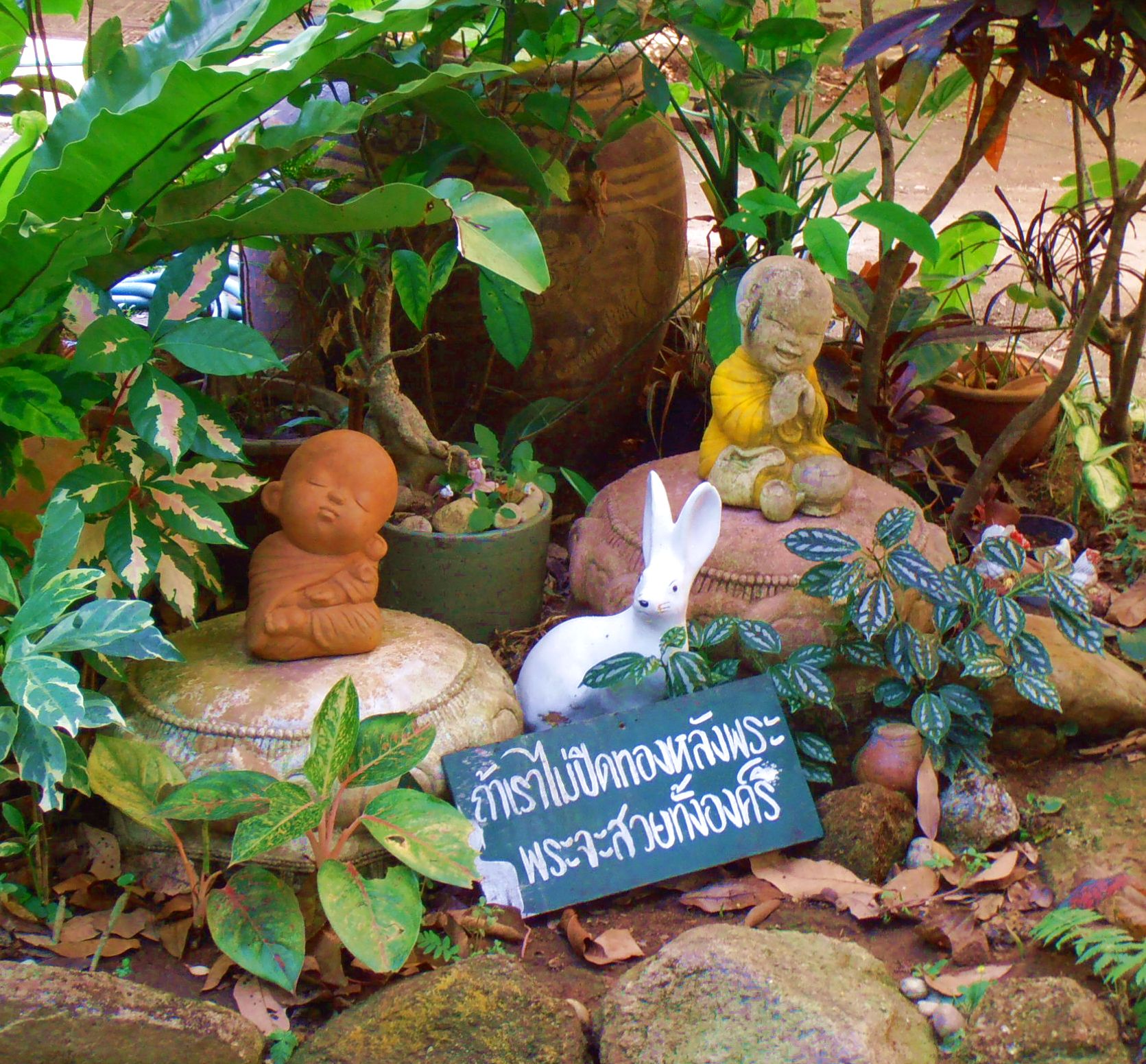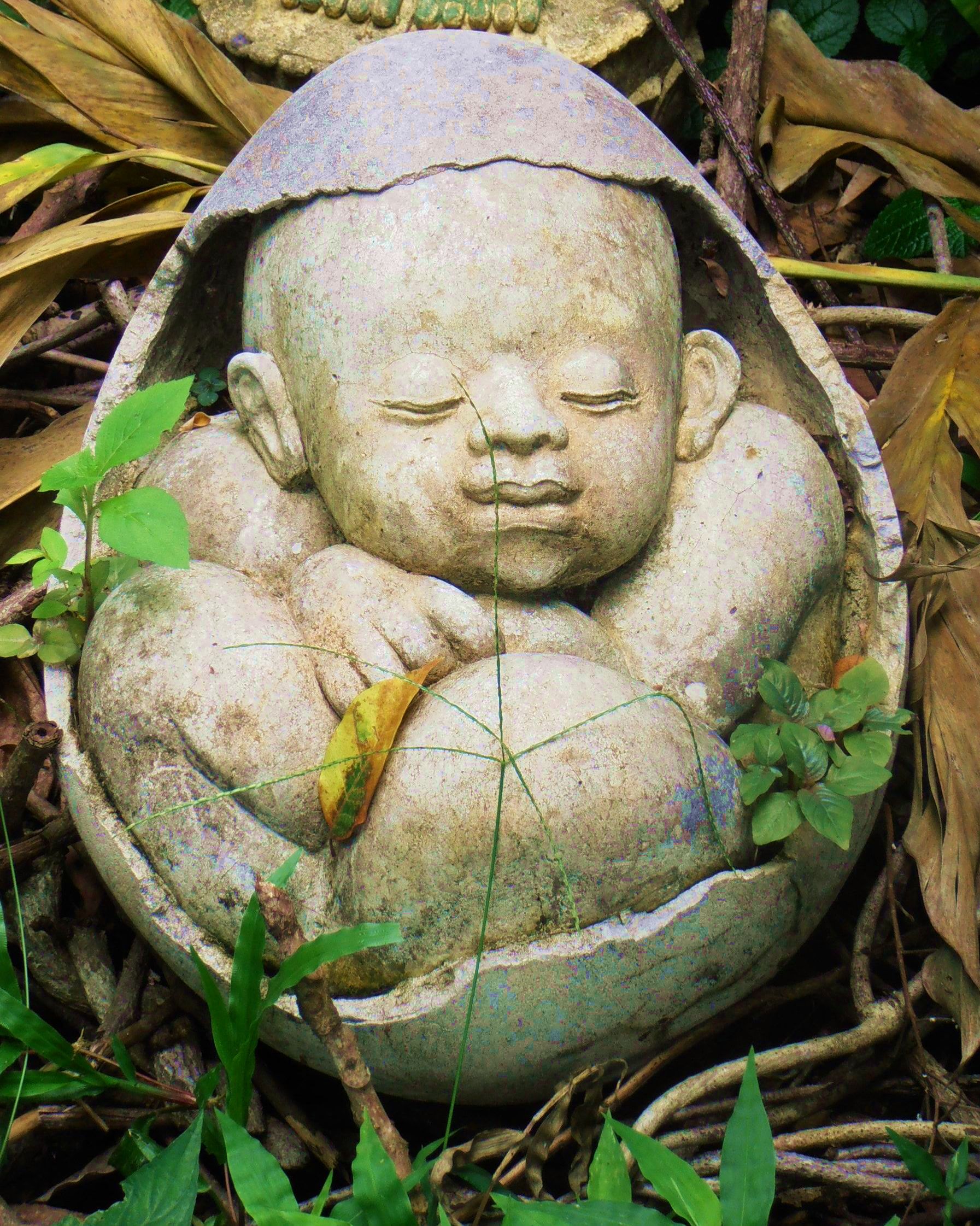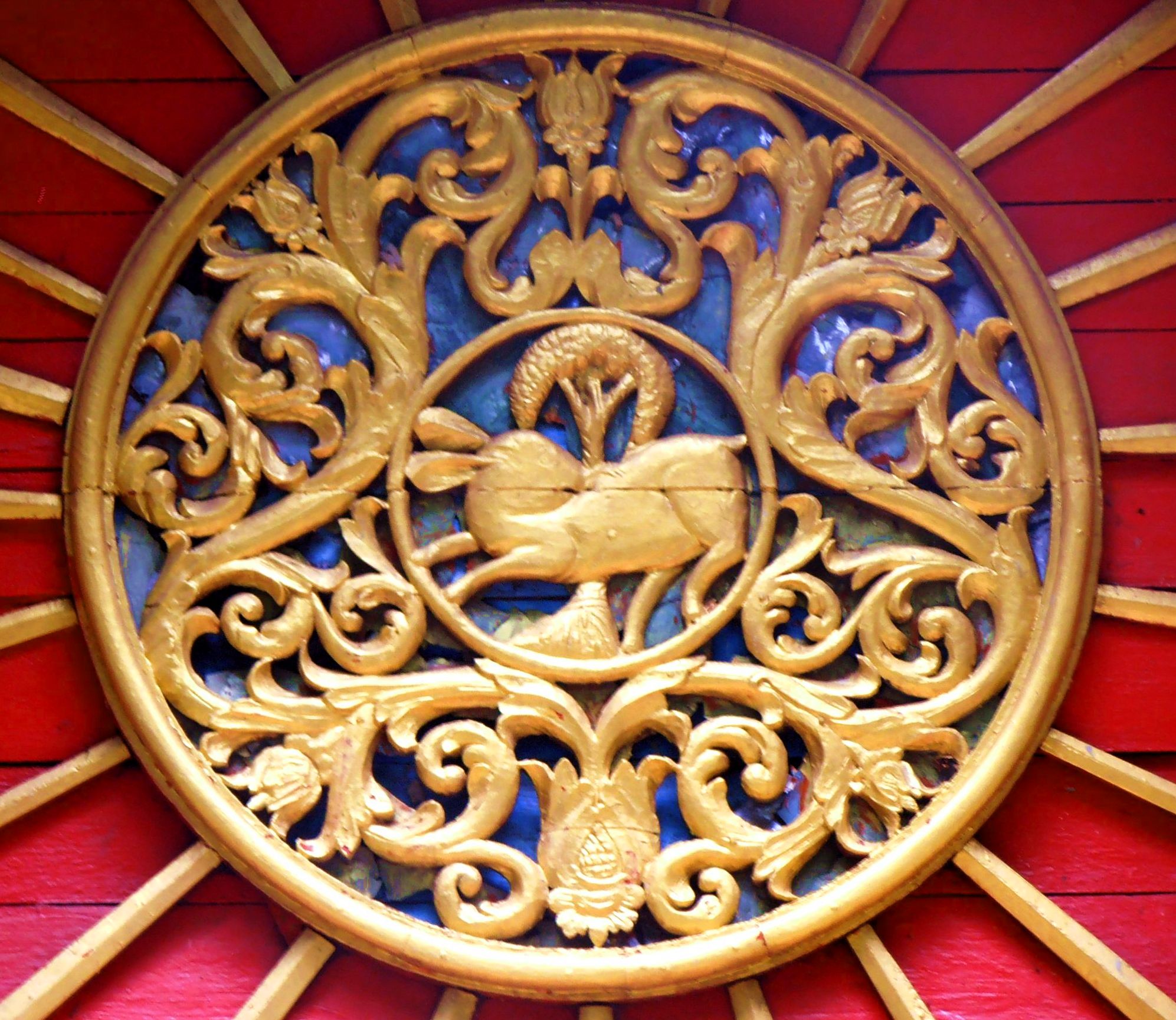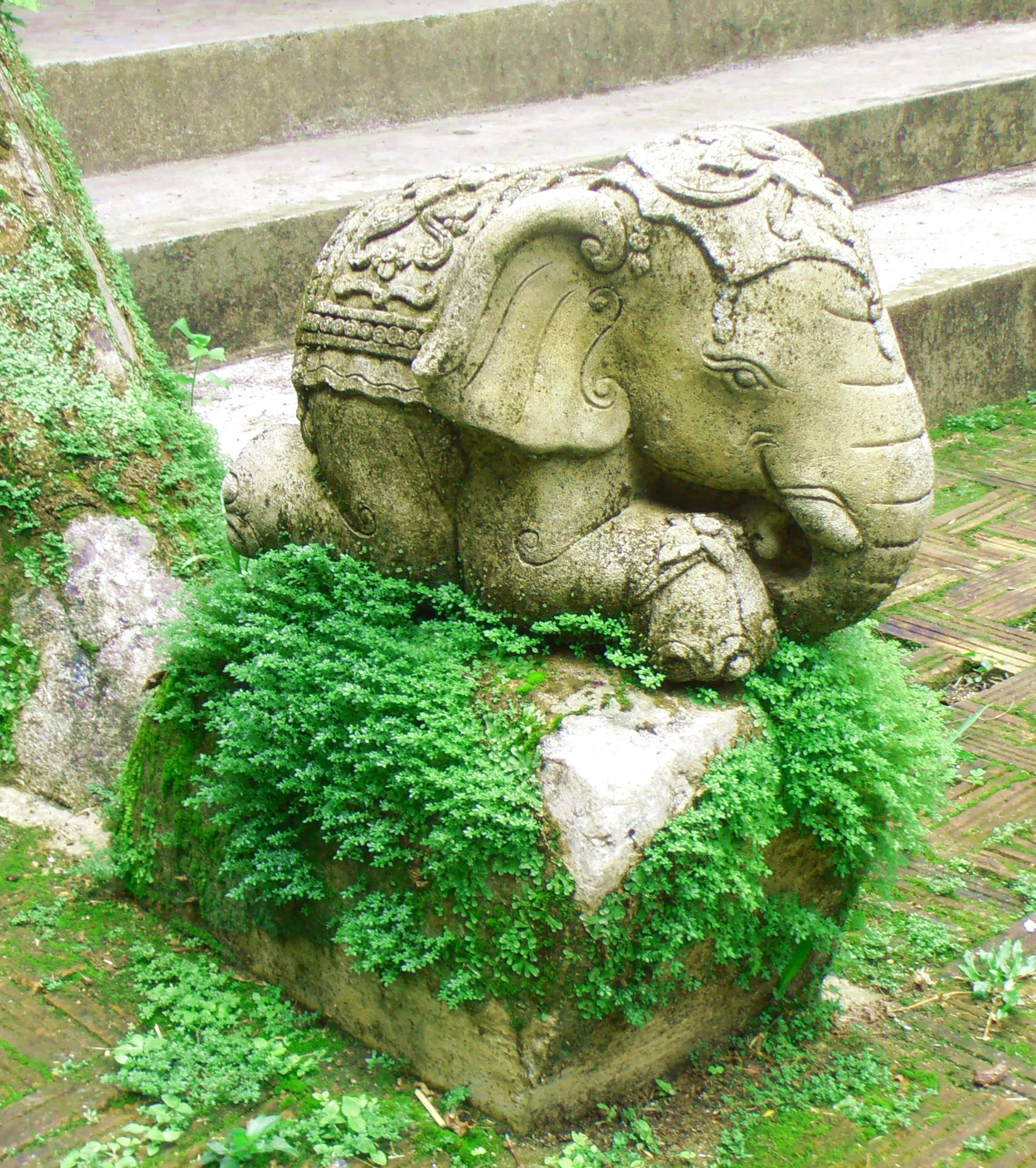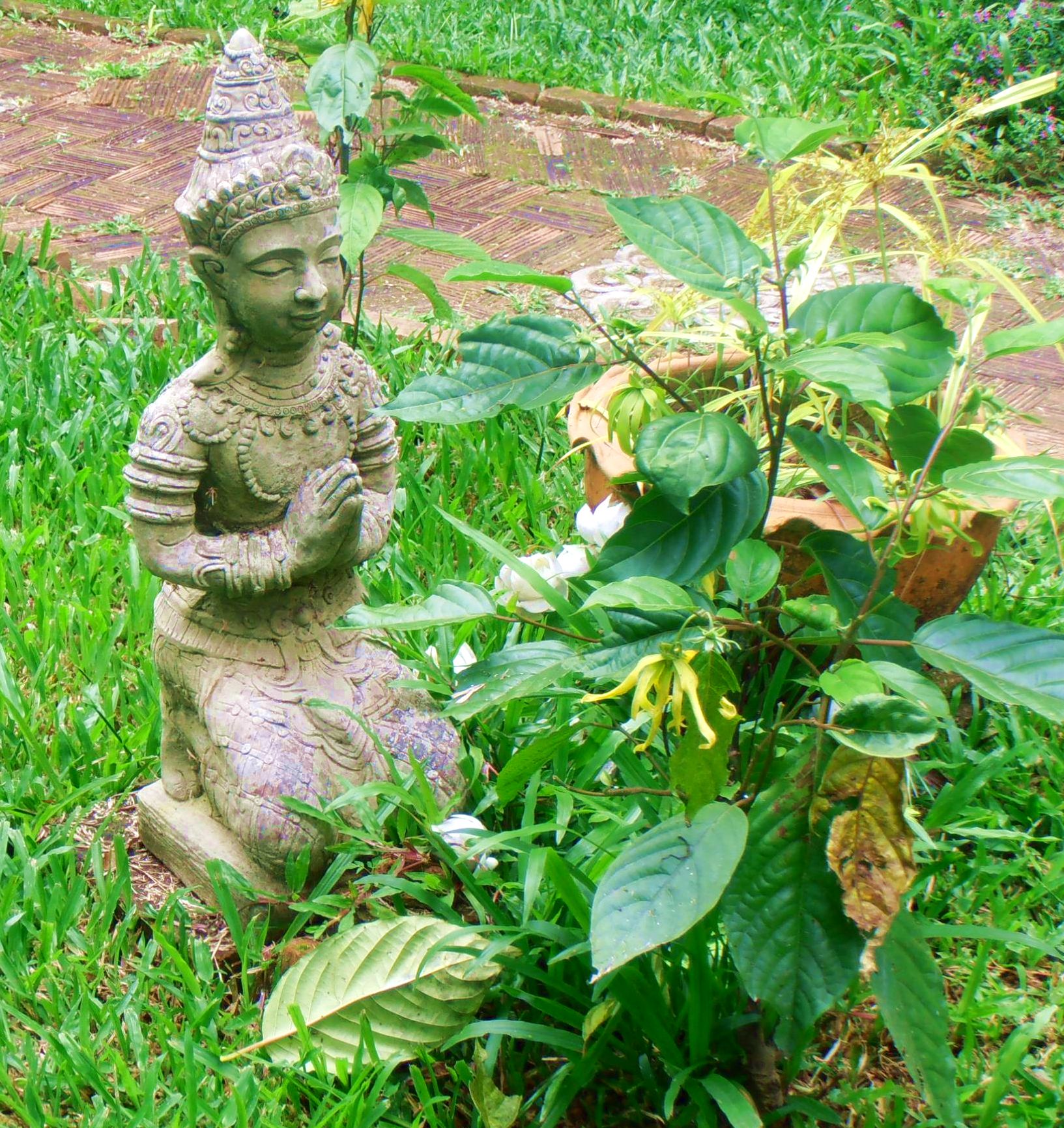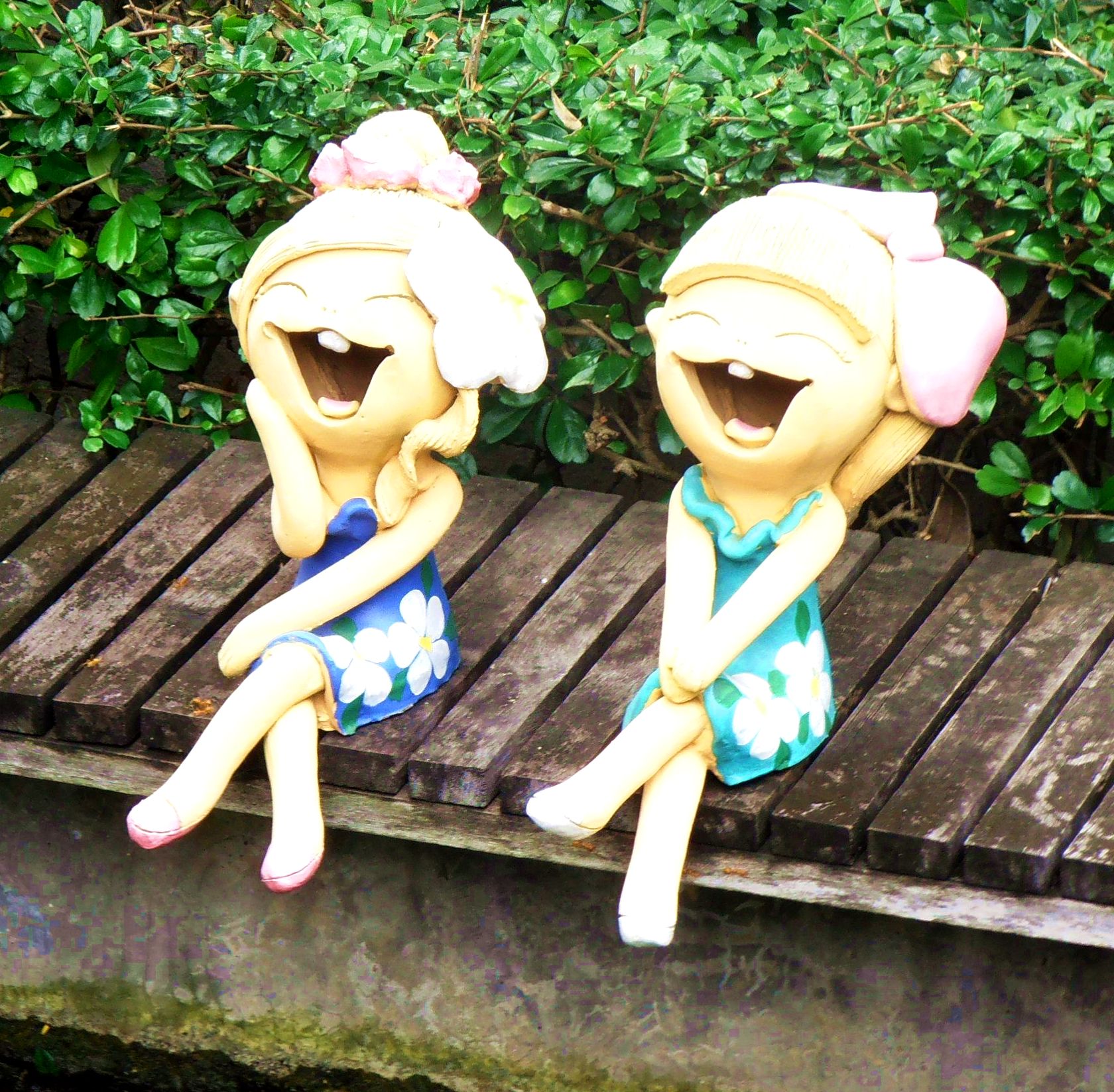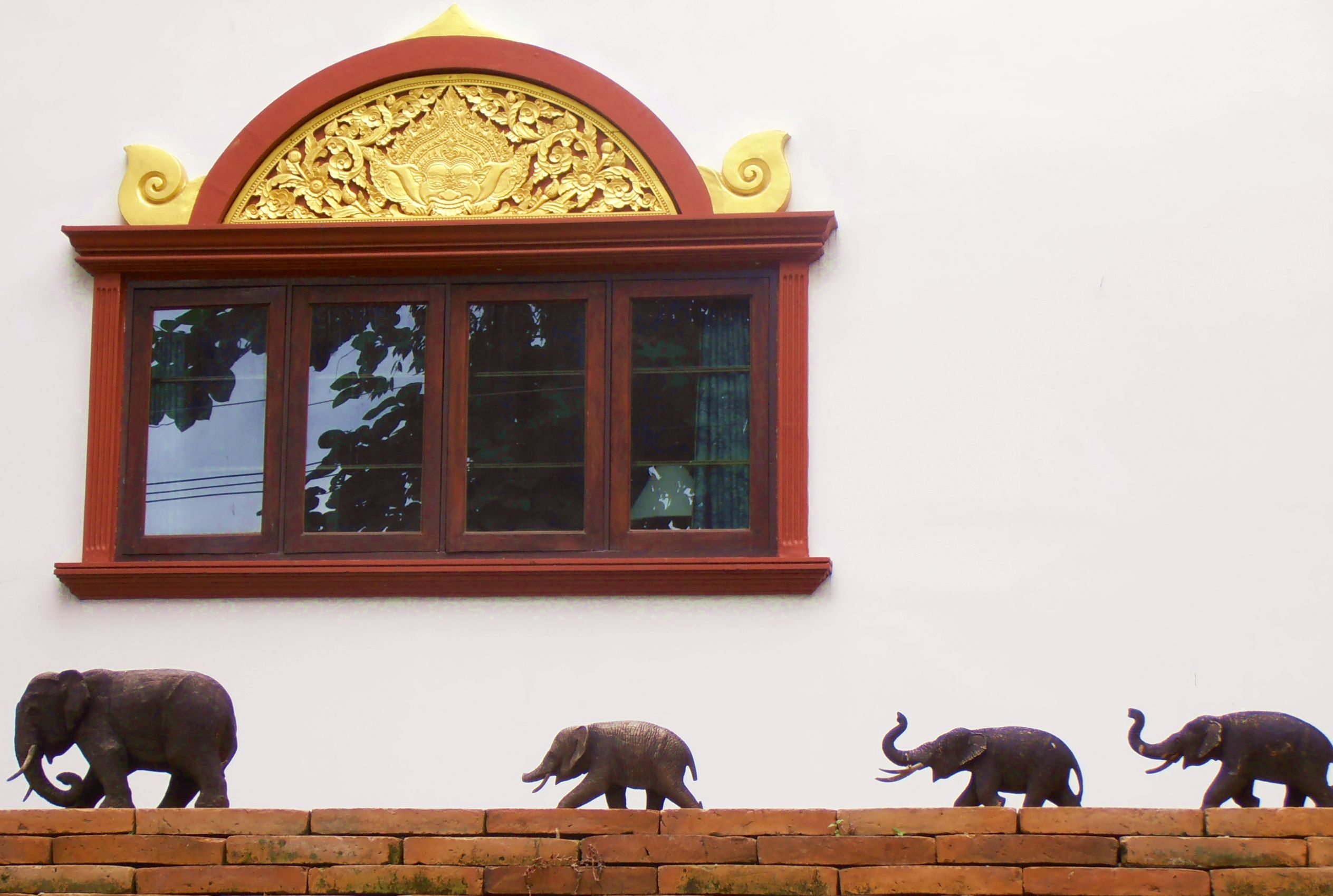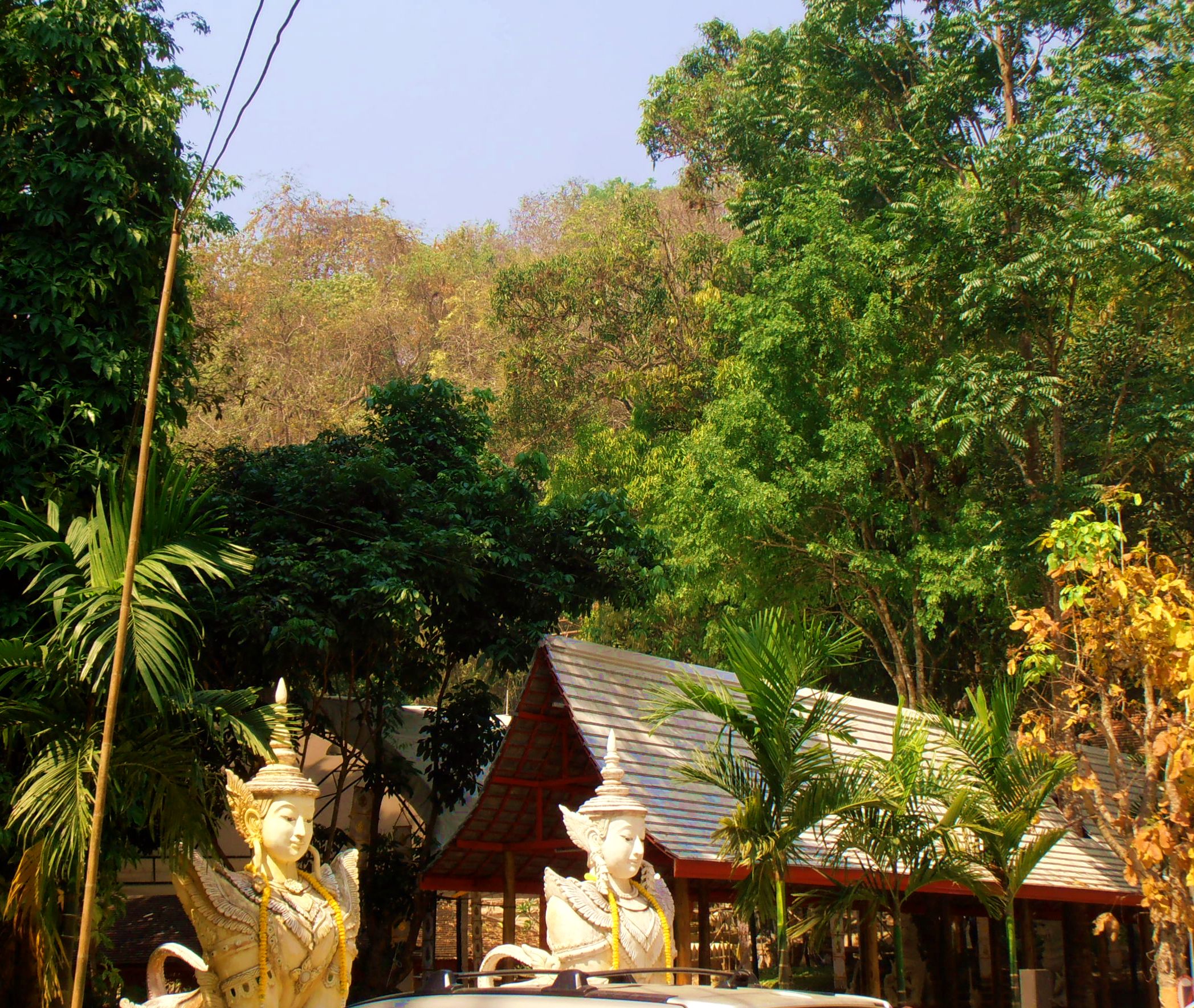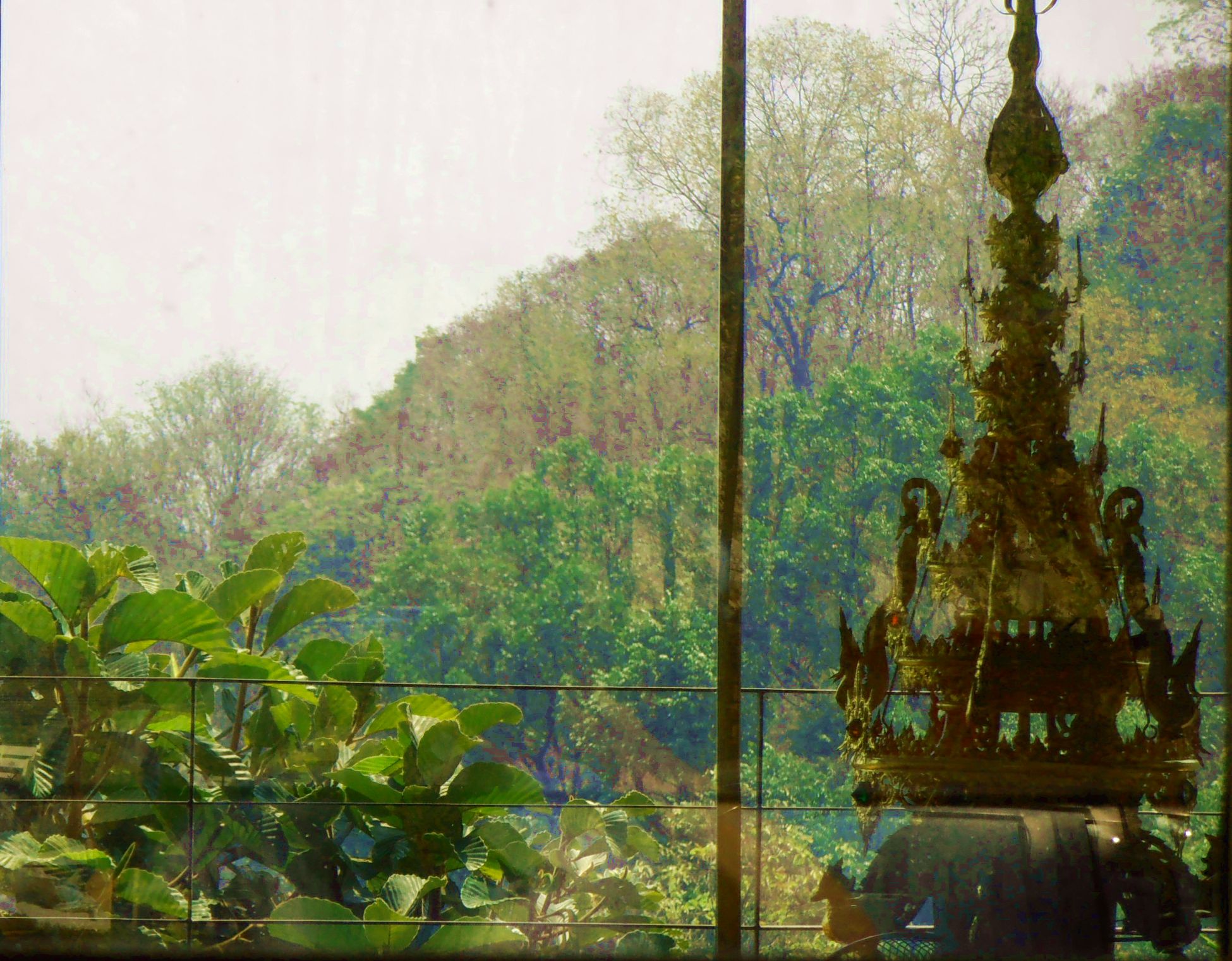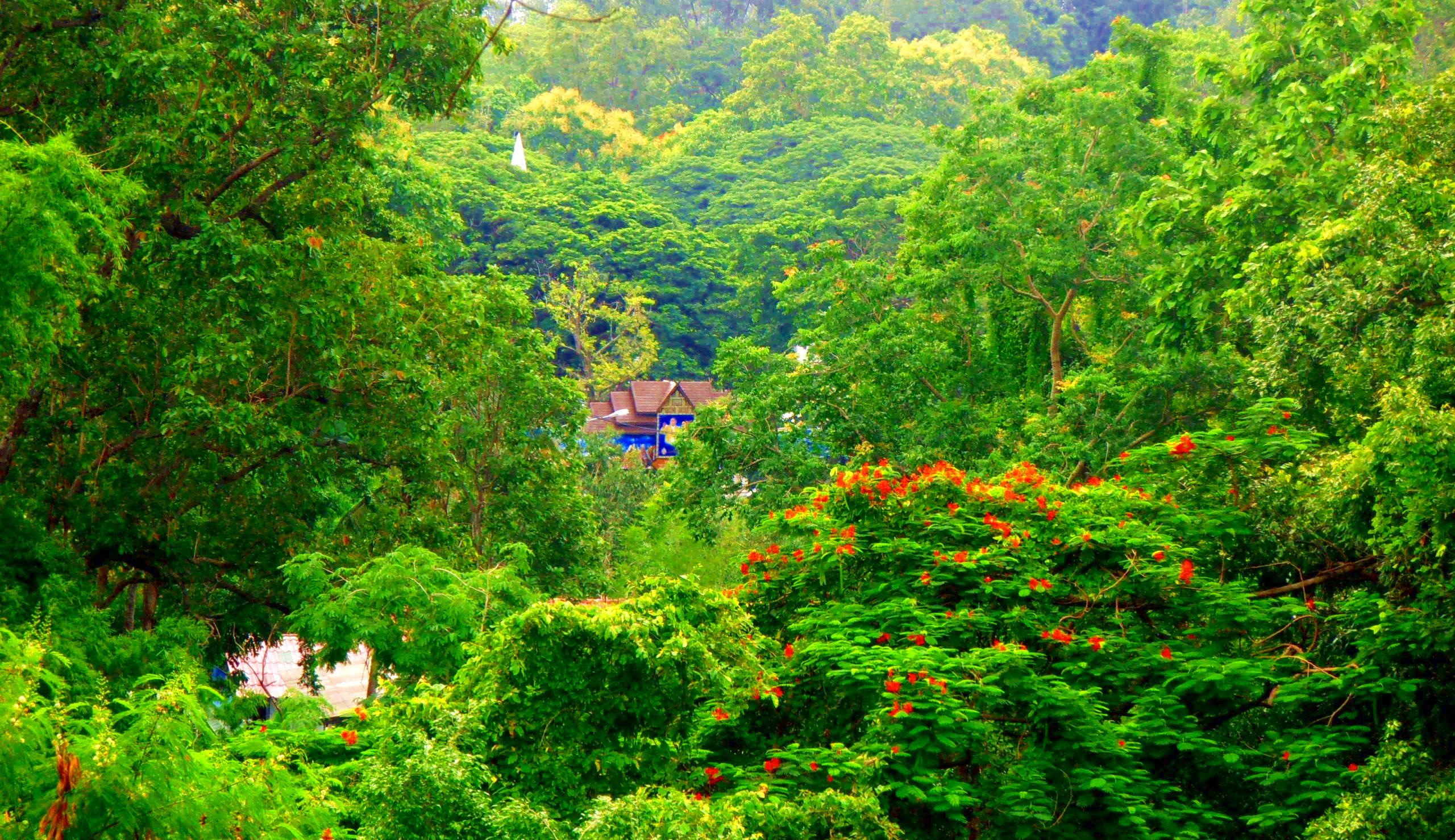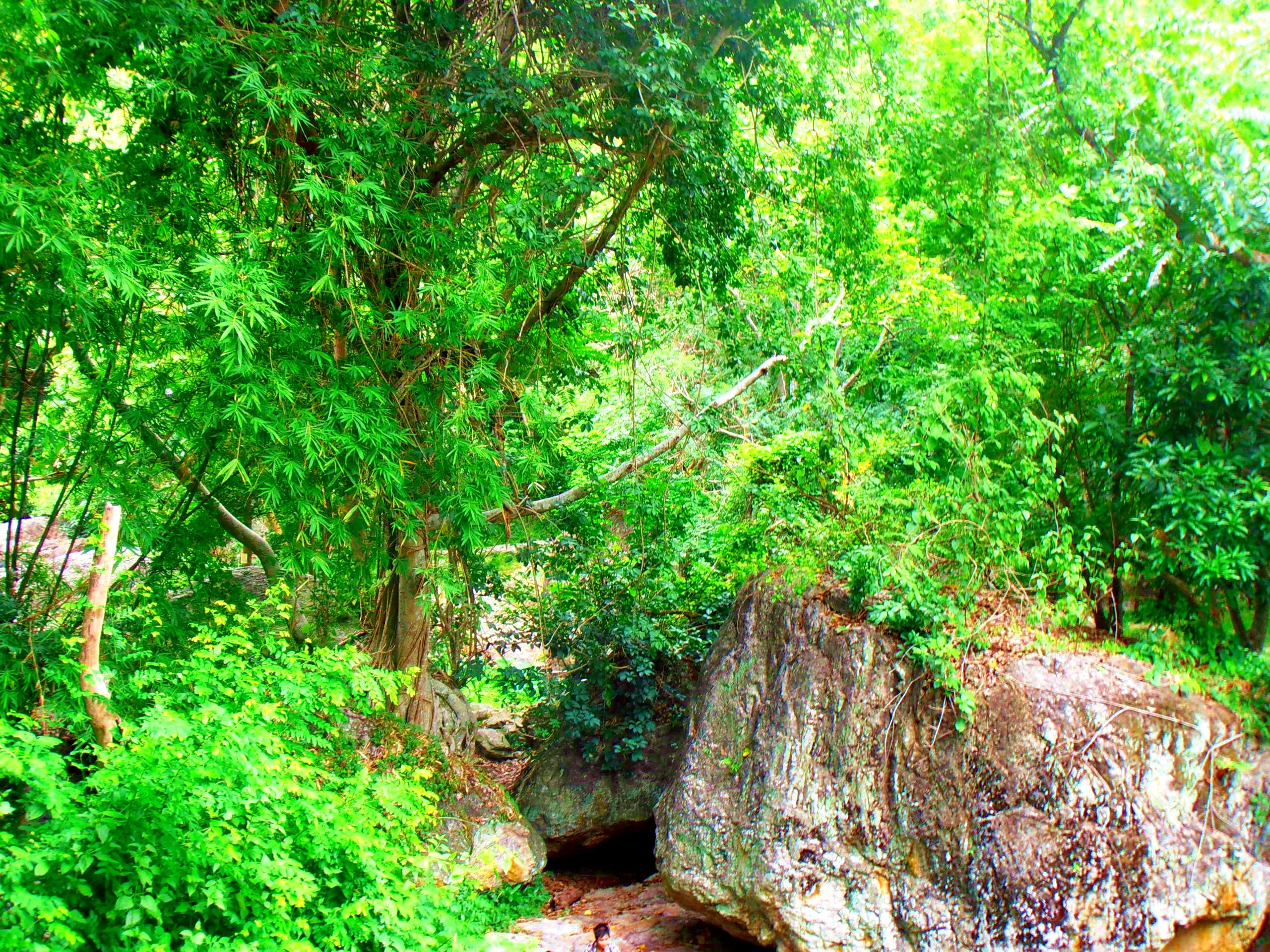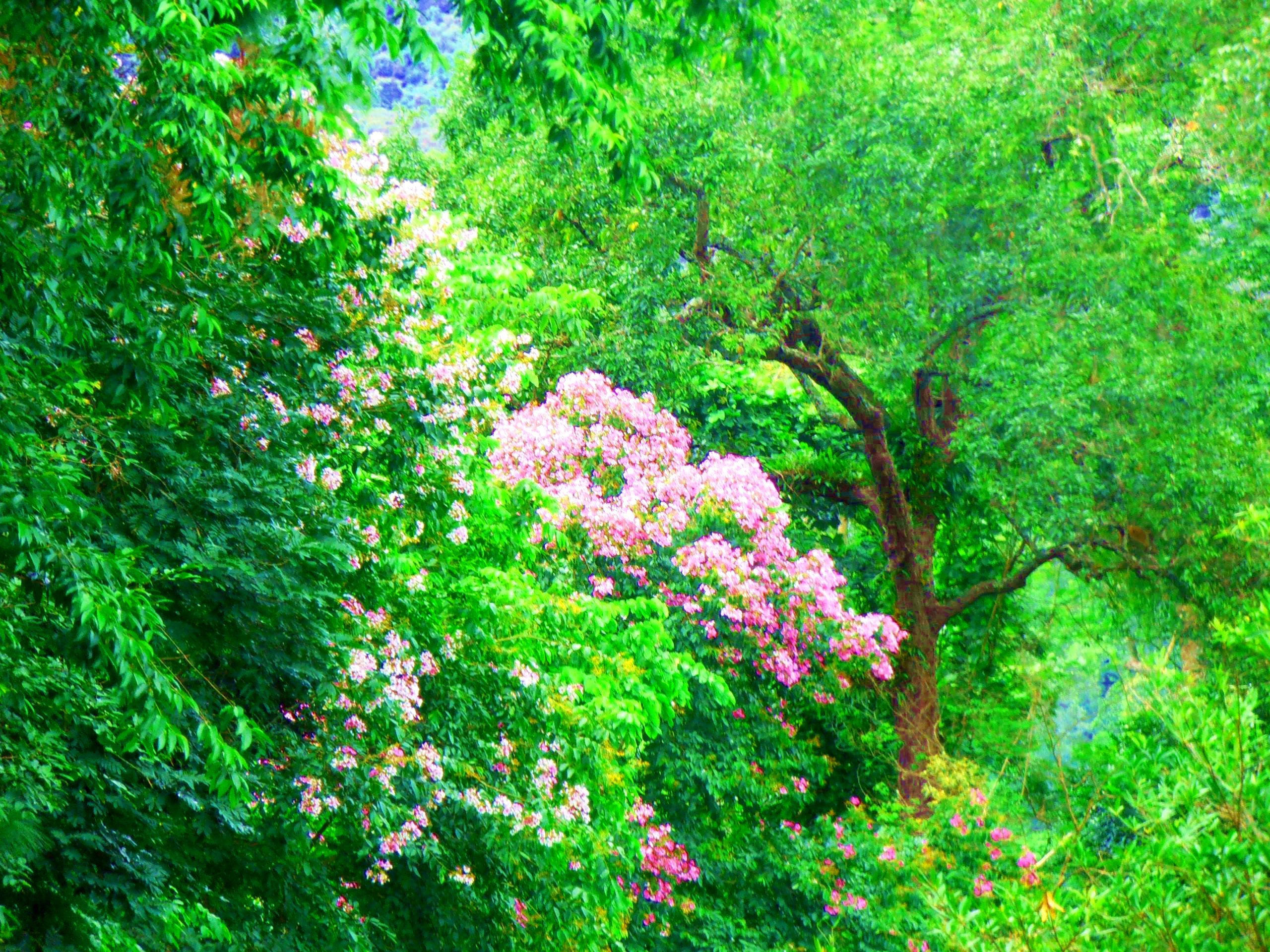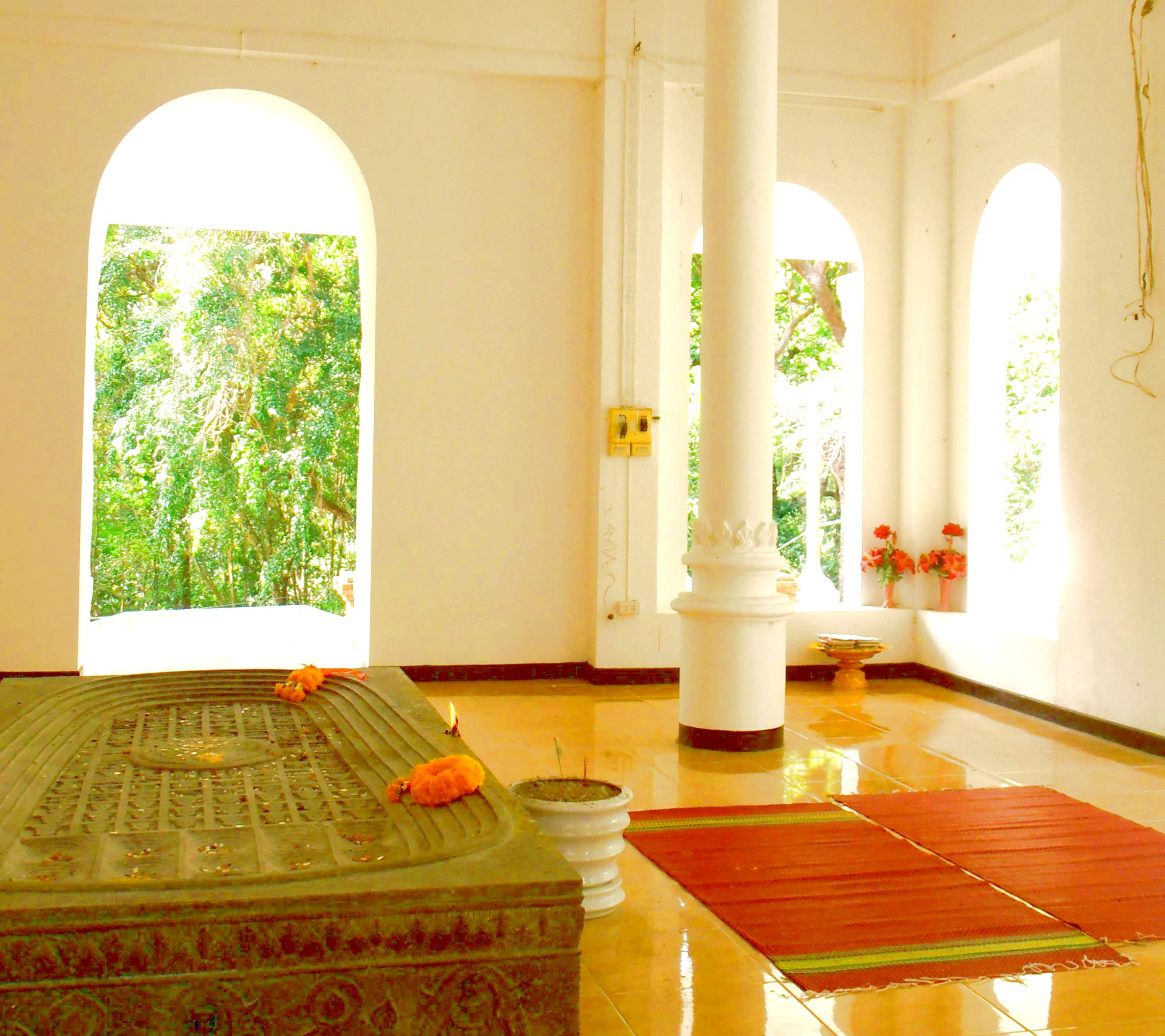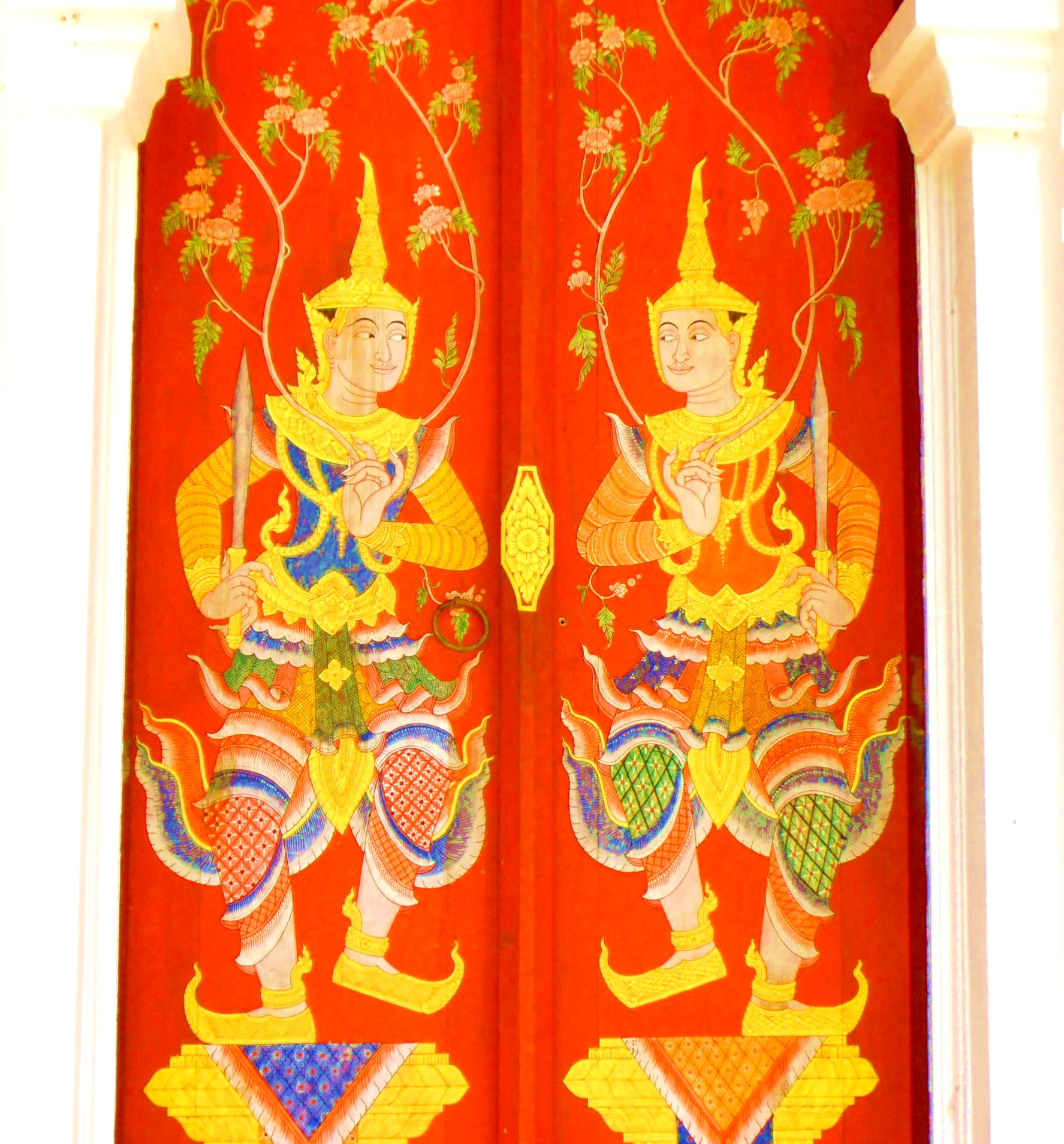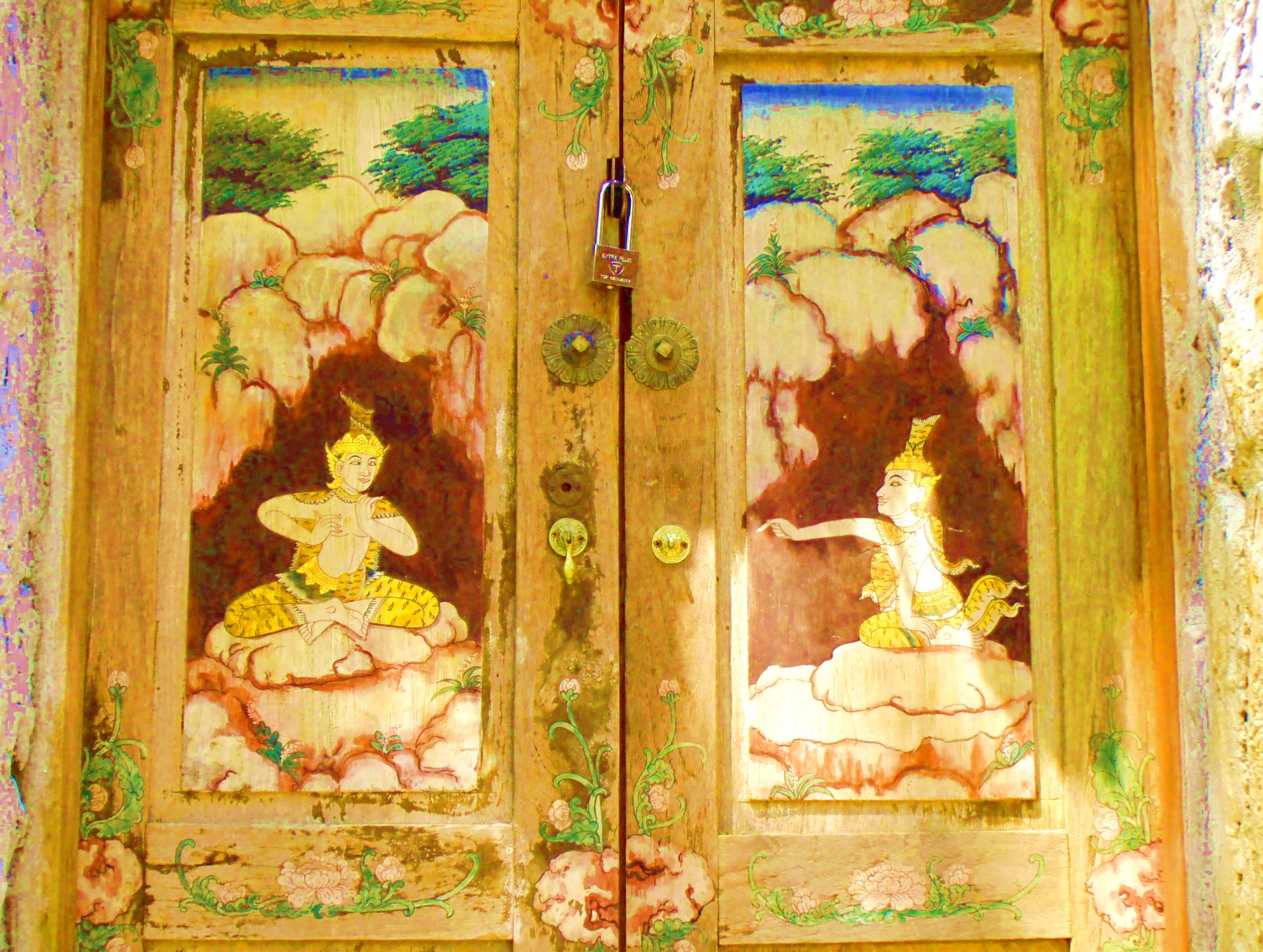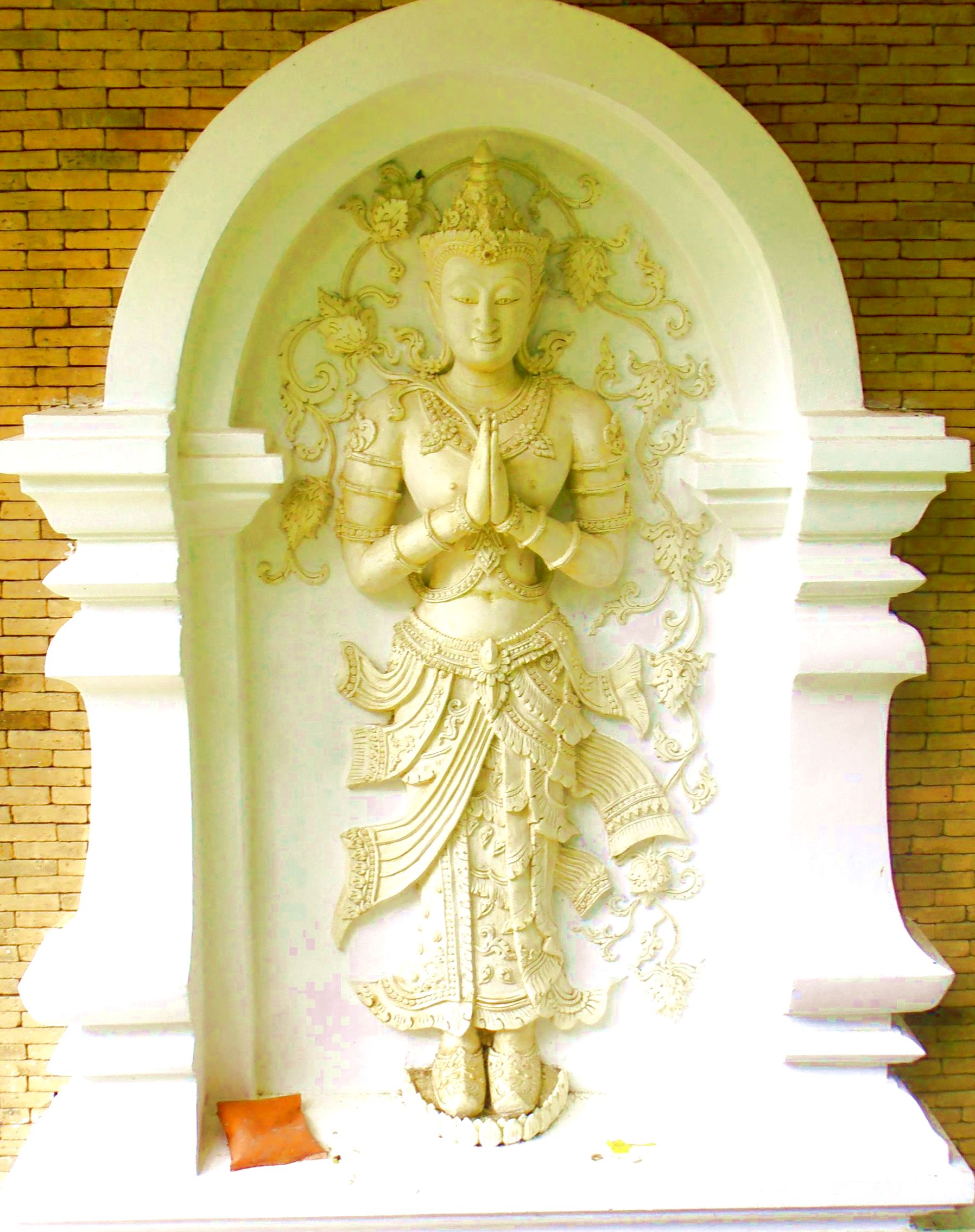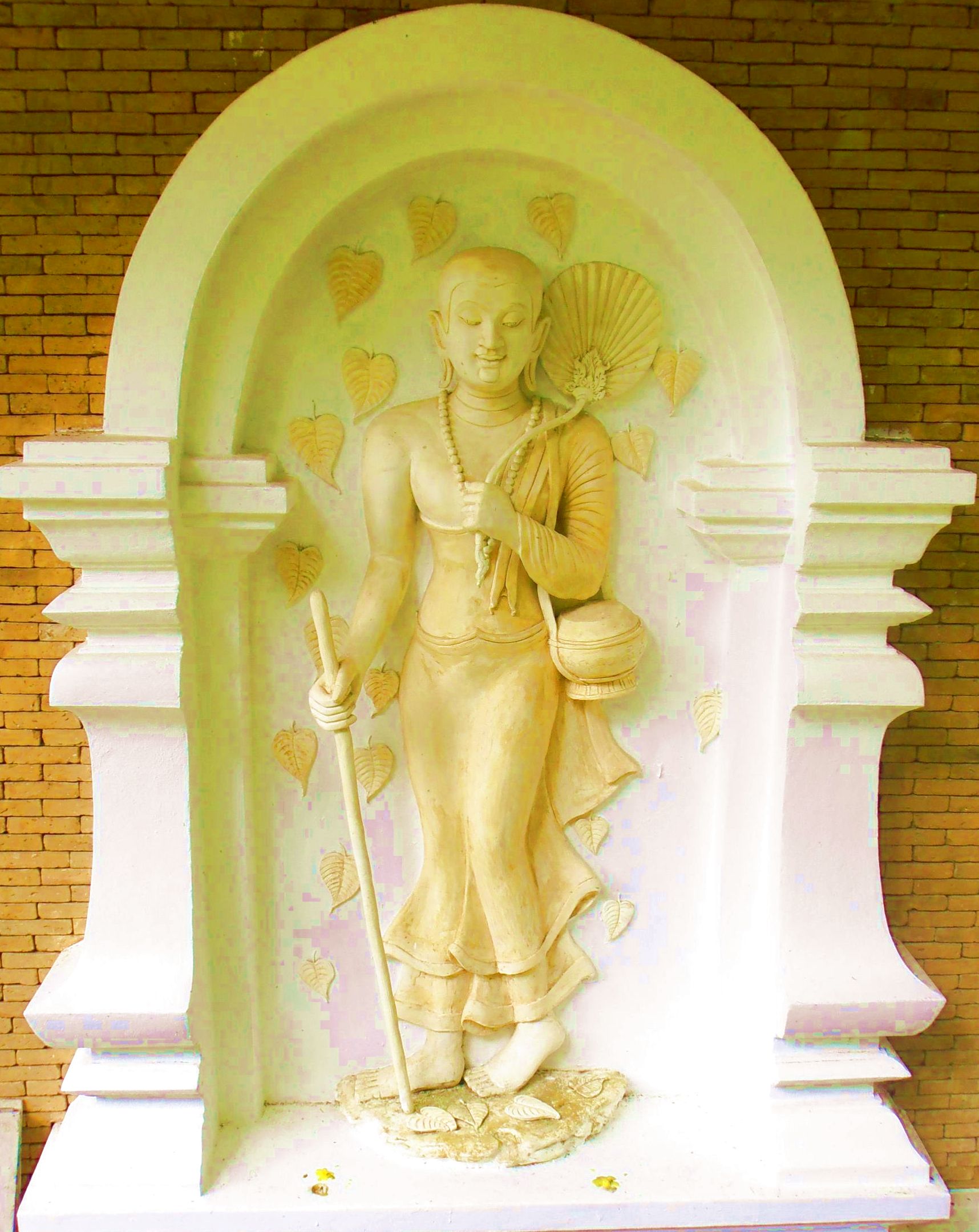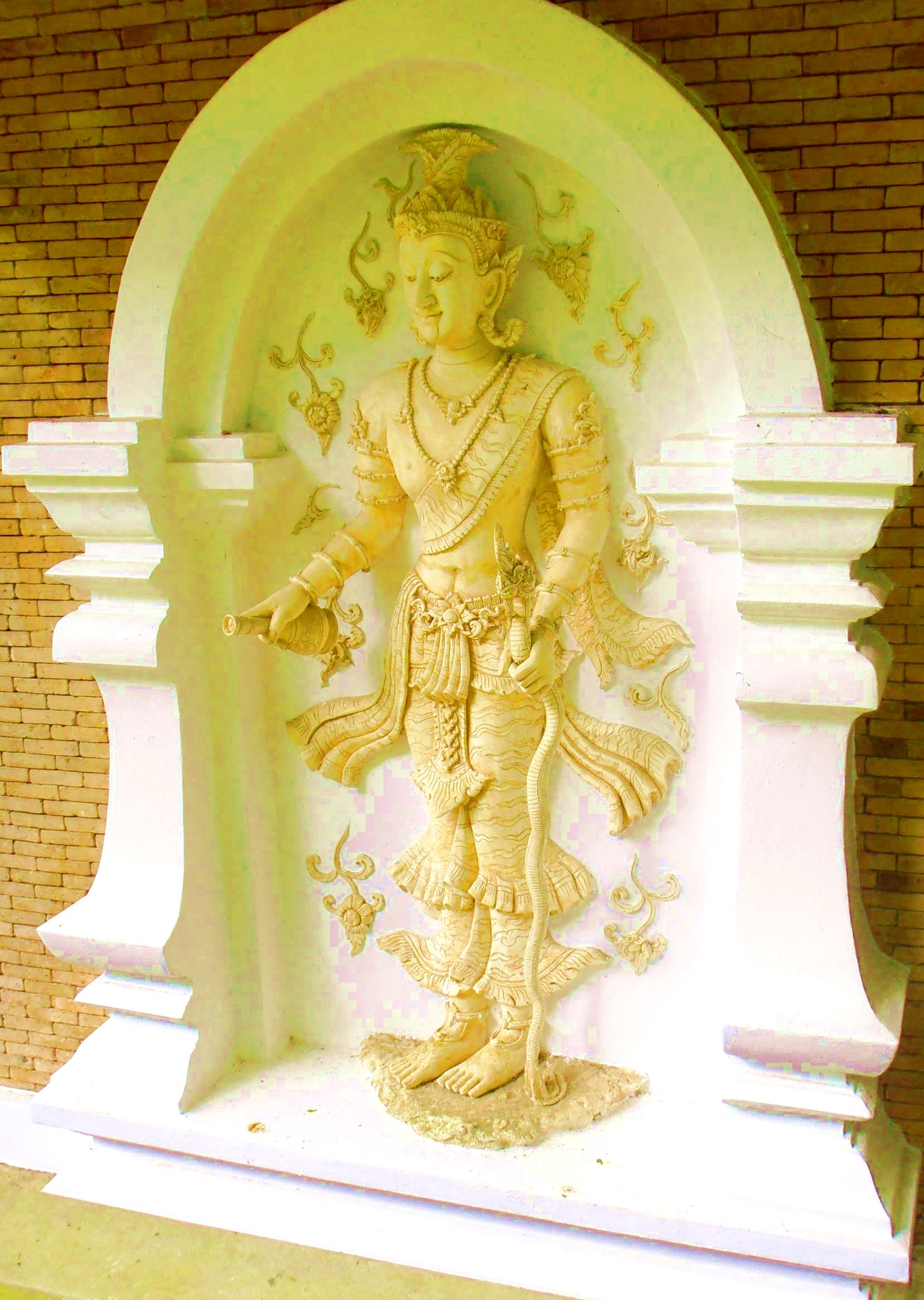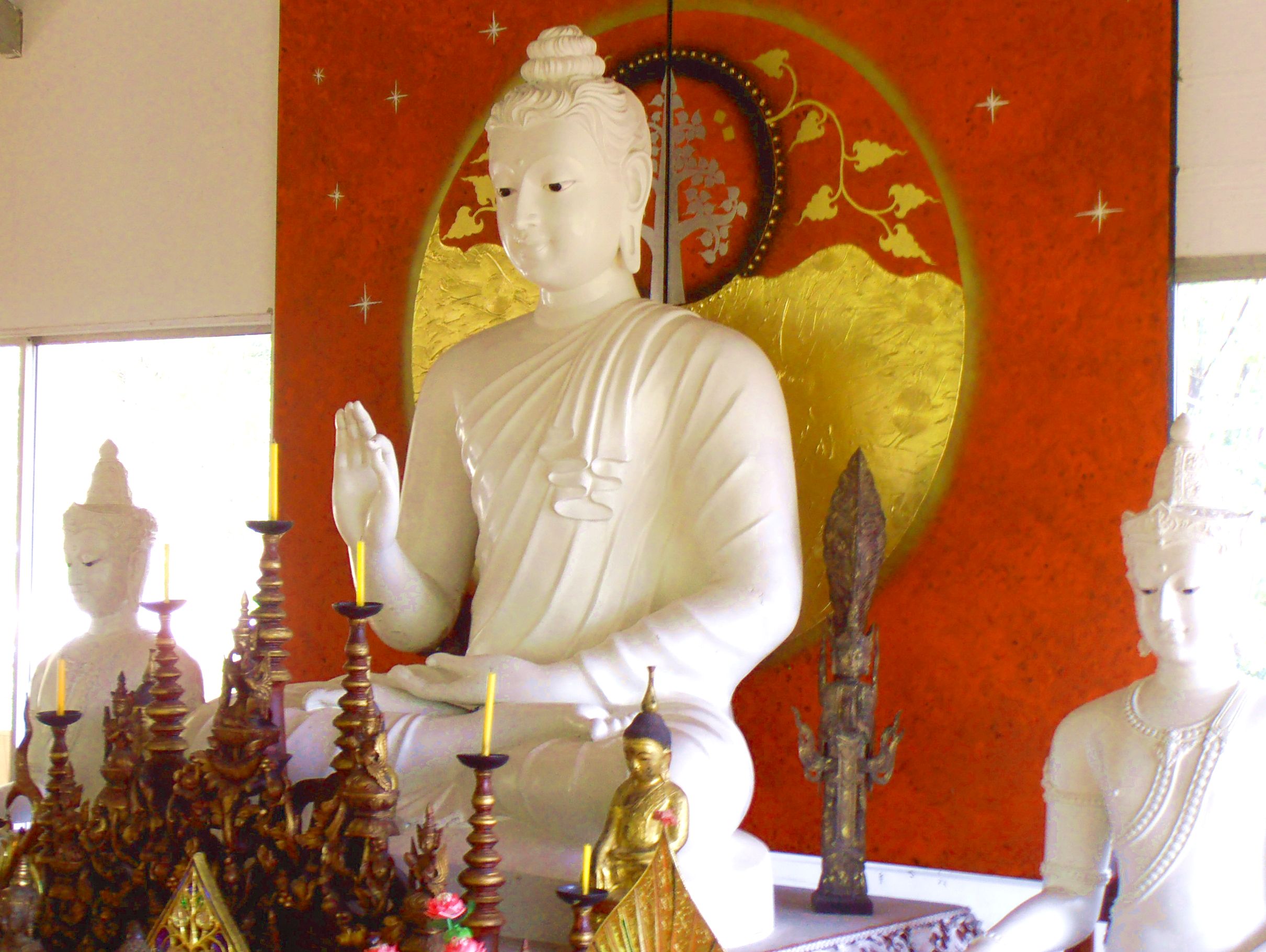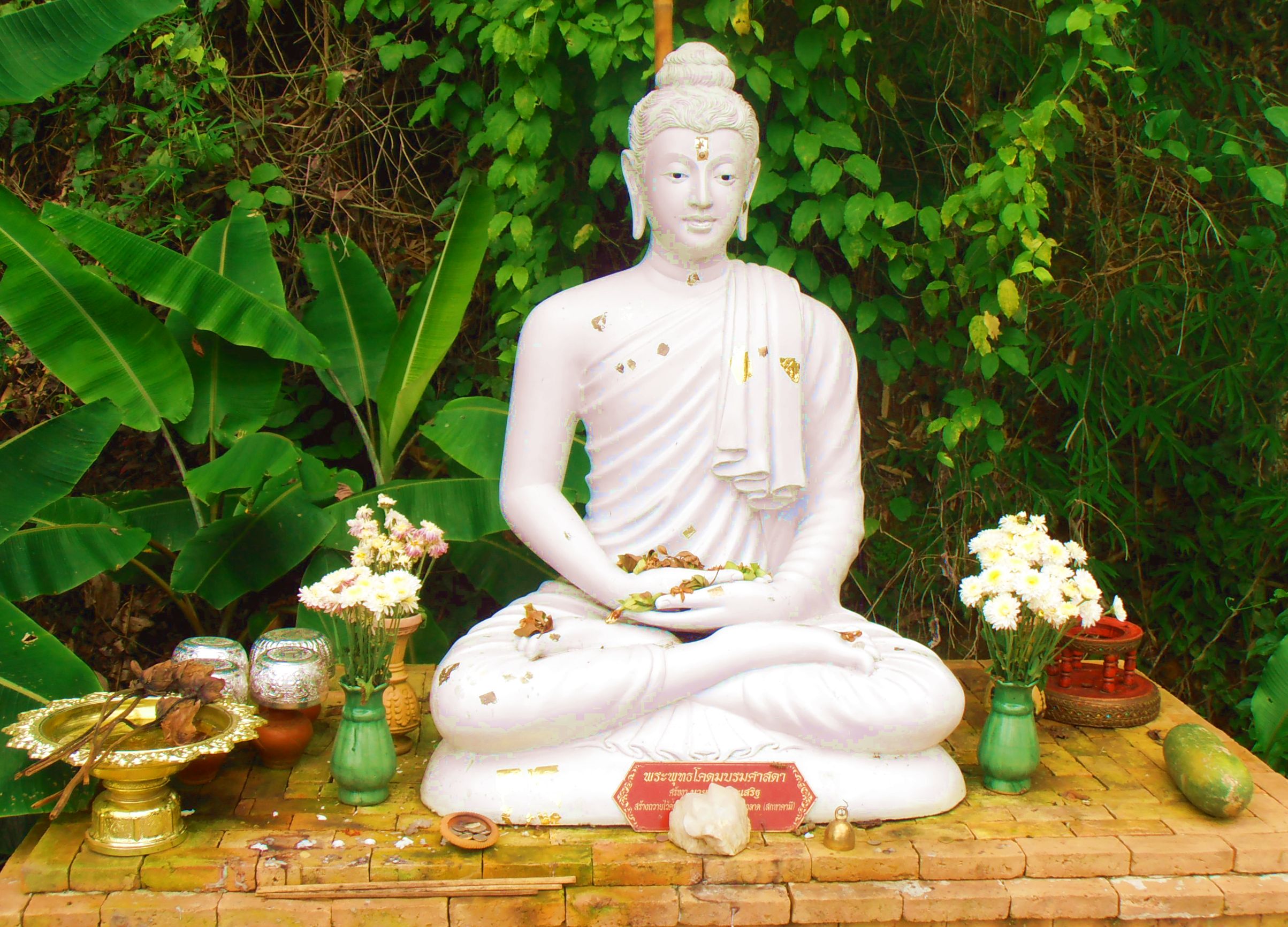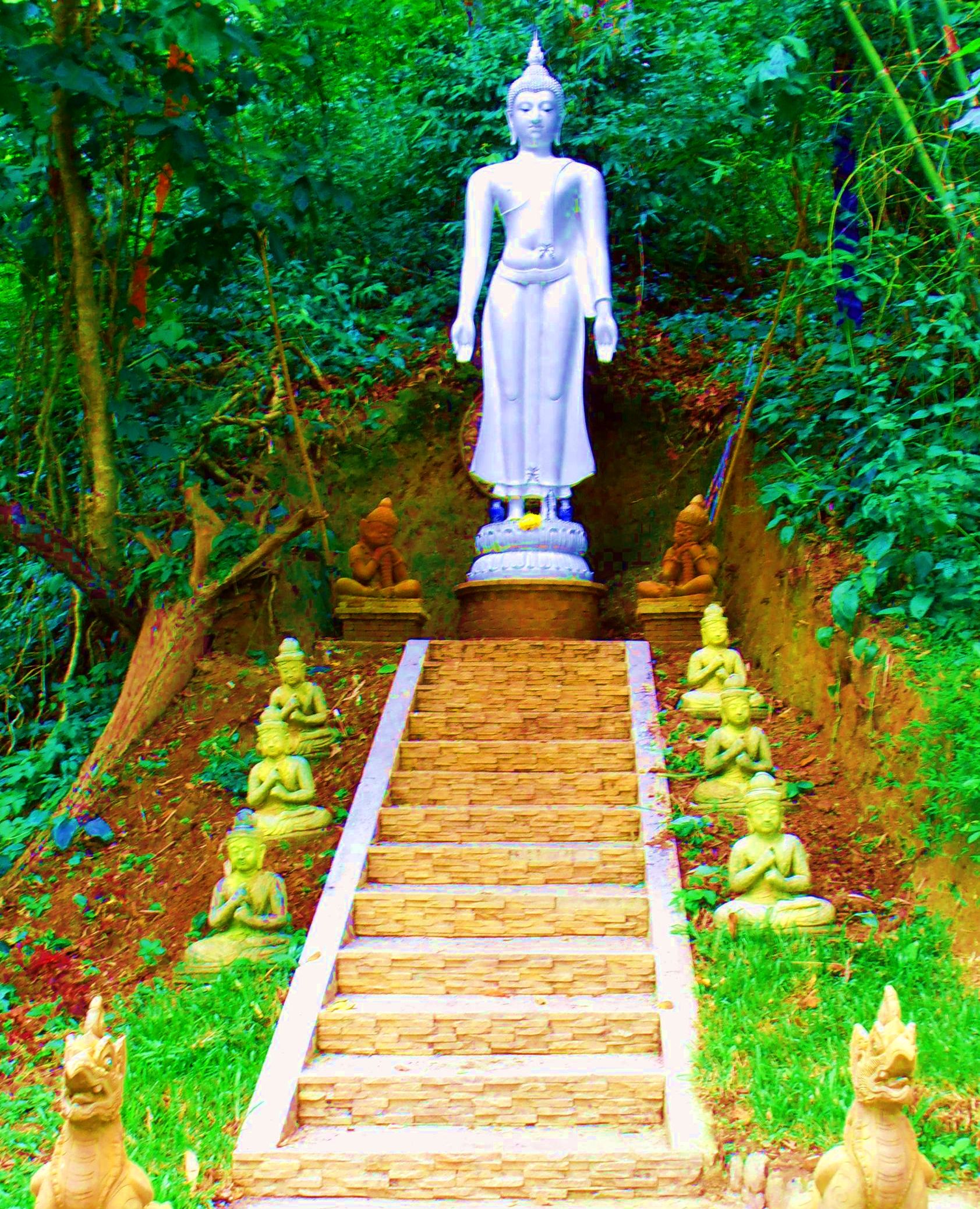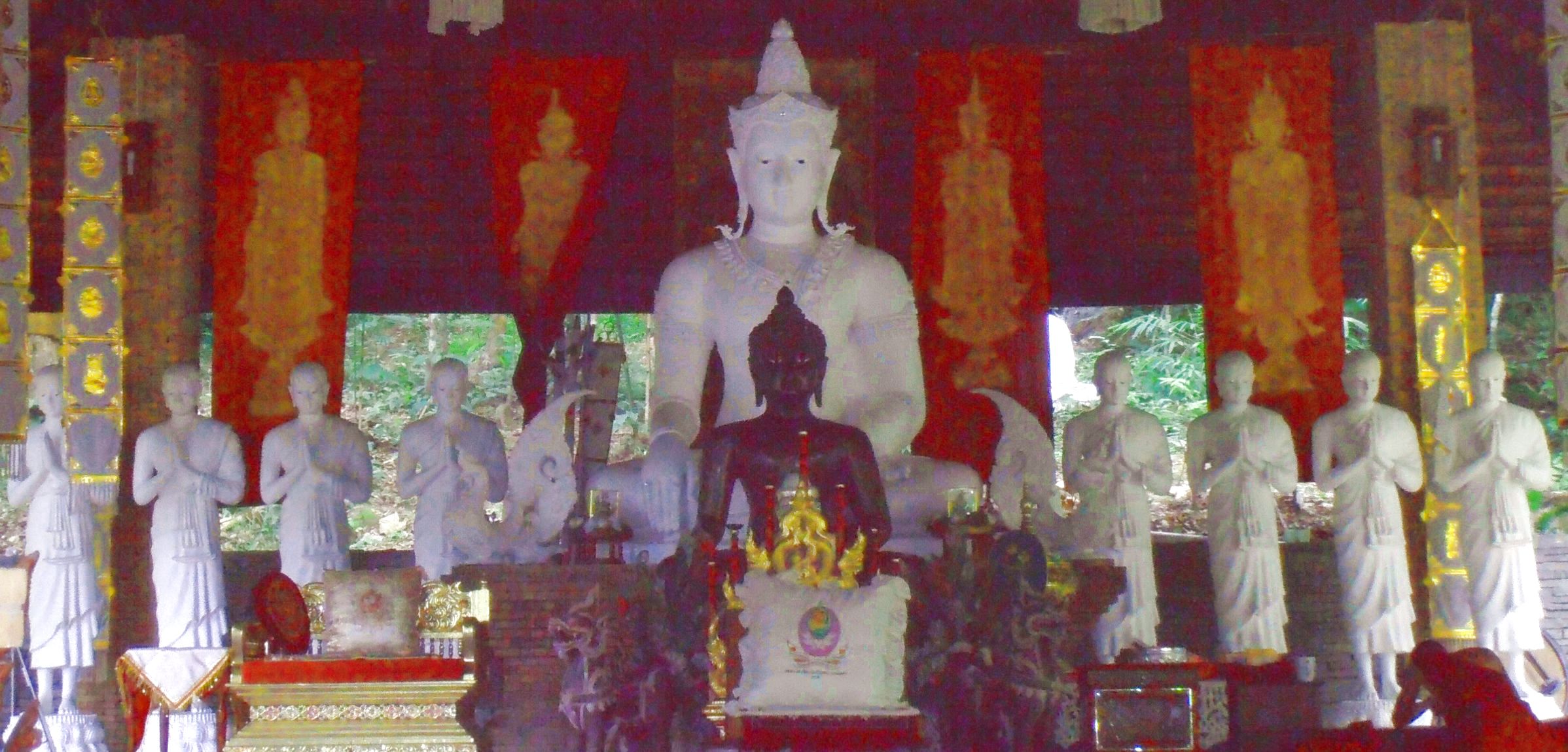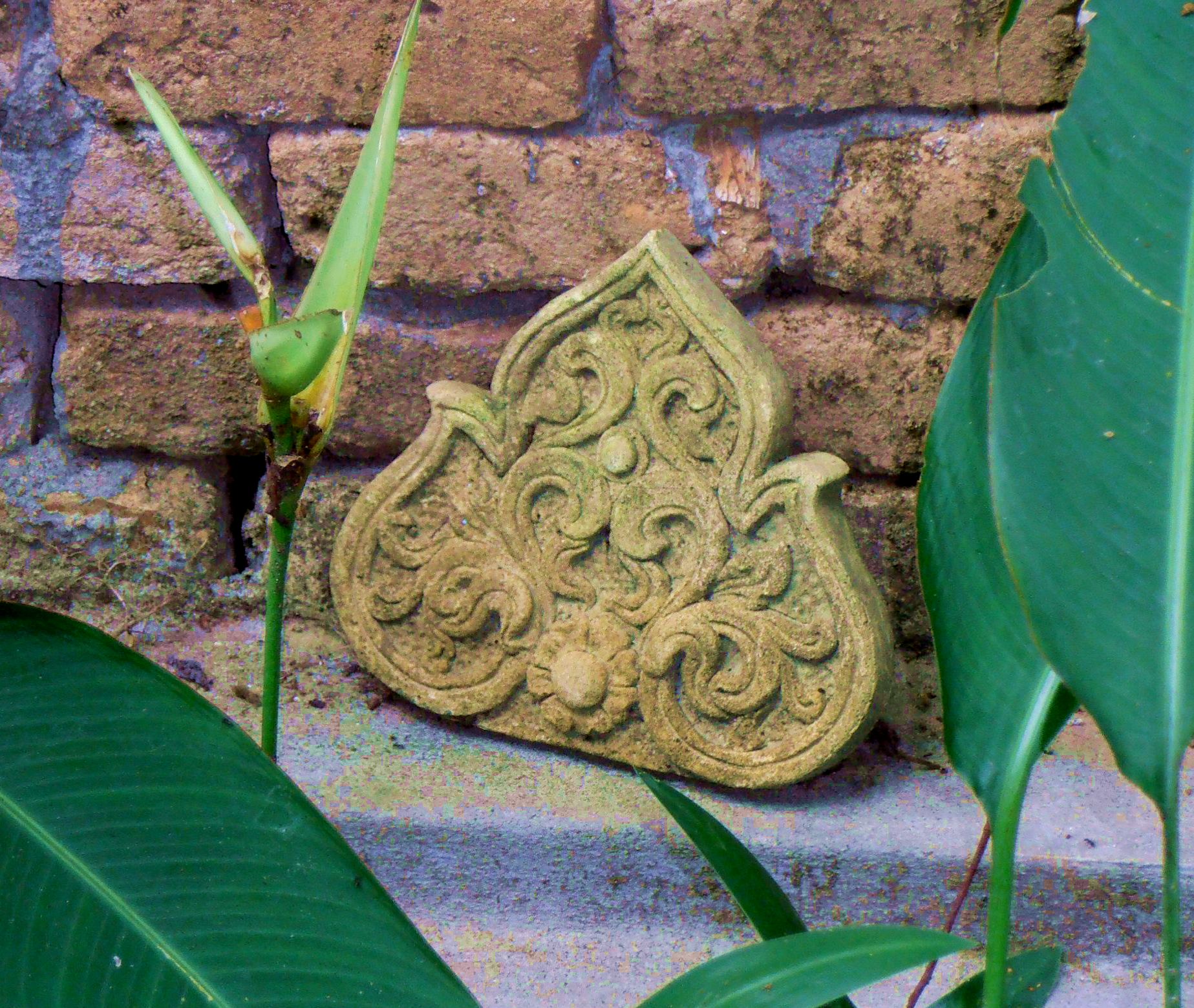June 2018
Absolutely the last thing that applies to the dozens of temples in Chiang Mai is the phrase, “If you’ve seen one you’ve seen ’em all.” Nothing could be more diametrically opposed to the truth. Every temple is like a world unto itself with its own character, its own atmosphere, its own aesthetic. Wat Palad sits on the side of Doi Suthep mountain halfway up to the main mountain temple, the pilgrimage site Wat Phra That Doi Suthep. The name Palad — alternatively transliterated at Pha Lat — means On the Sloping Rock. It’s pitched on the mountainside at a fairly steep angle, so moving up and down is as important to one’s experience of the site as is moving back and forth on the various levels. Its perch on the side of the Doi Suthep affords wonderful views over Chiang Mai and the Ping River Valley (on a clear day, in any case, may the Tourist Gods smile upon you). Before the road from Chiang Mai to the main temple was built in 1935, Wat Palad served as a way station for pilgrims making the ascent up the mountain on foot. Since the road was put in, few people now visit it. That’s a great pity, because its setting is unique and its aesthetic is at once unusual and delightful. It has the sense of being a thoroughly human place, not just a place of religious veneration. I carried away with me from my first visit the special atmosphere it creates and some months later the word came to me I had long sought to capture that sense: Rivendell. Wat Palad has the same quality of serenity and beauty that Tolkien gives to the Elvenhome Rivendell in The Lord of the Rings. Fortunately, there’s no Dark Lord up to nefarious business in the dense surrounding forest, there’s just more Buddhist loveliness at the main temple a bit farther up the road. This Thai Rivendell gave refreshment to the travellers it welcomed without the need to provide protection into the bargain. To those today who need a respite from the noise and commotion of the city it offers a haven where all is peaceful, calm and beautifully quiet. The sound of running water is what most often greets the ear.
Wat Palad is not the place to see monumental temple architecture. The buildings are small, almost unassuming, and entirely subsumed by the forest around them. To name the place Wat of the Tilting Forest would be perfectly appropriate. The slopes of the mountain are visible from all parts of the complex and a view of the forest is almost always present from whatever vantage point you choose. If you’re after monumental architecture, then you need to head up the road to Wat Doi Suthep where you’ll find it in abundance. Wat Doi Suthep commands its position on the mountainside with great majesty. Wat Palad is nestled in the forested slopes like a deer bedded down for the night. It obtrudes not at all and its strength is exquisite detail, not grandeur. I’ll let some pictures do the talking.
The paths invite you in several different directions at once and you choose your route based on your own inclination. Any direction you take will bring you to something lovely and have a myriad of handsome details to take in along the way. Here are some examples.
The wandering I did so gladly and for so long a time at Wat Palad reminds me now again of The Lord of the Rings. I was like a Hobbit from his rustic Shire struck by the fantastic sights of Elvenhome. At times the sight of a particular ornamental grouping caught my attention because it could well have been from the garden of someone’s granny, but never did anything I see cause the corners of my mouth to turn downward as lawn gnomes are certain to do. Even the ceramic bunnies sitting in the greenery seemed to me perfectly apt and appropriate for some reason I can’t name exactly. I’d certainly never have any such thing in my own garden, you can rest assured on that point. Homey don’t do chachkas. Somehow these figures in their setting escape the tackiness that would be their only hallmark if I plopped them into my garden. The magical environment in which they’re embedded makes all the difference. It’s an environment in which everything appears sacred, where everything has its rightful place in the scheme of things, myself the wanderer included. And let’s face it, as I go about the place I’m an ornament considerably less aesthetic than anything you see in the pics. If the place can apportion even to me a rightful place in its aesthetic scheme, then we’re dealing with very powerful magic, indeed.
A stream — I think it’s called a river on the map, but that’s giving a bit too much credit where credit is undue — flows through the compound, tumbling down from its source in the higher precincts of the mountain. Running water is always lovely, of course, even more so if it’s from a natural source rather than from the plumbing of a fountain, but the stream at Wat Palad is incorporated into the complex in a way I’ve not observed in any other place. The stream’s course has not been altered; it’s a completely natural phenomenon. You perceive it, however, in the bosom of these delightful vistas and ornamental details so that it becomes something other than a natural stream in the forest, nor is it reducible to a “water feature” like you’d see in a Western garden. It is itself and at the same time an integral part of the temple complex. What a lovely synergy to see, and what a fine testament to the Thai sense of composition using natural elements together with creations from the hand of man.
I think the reason the complex feels so homey (or homely, if you’re British) lies in the similarity of the ornamental scheme to others I’ve seen in purely secular venues. The decorative groups placed everywhere along the pathways and in the garden areas remind me of funny or particularly handsome things I’ve seen on the patios of cafes, on the grounds of restaurants, or in the forecourts of hotels. Here are two examples, one from a cafe and one decorating a residential wall in the Old City. I think both groups could easily be put into service at Wat Palad without any injury being done to the aesthetic there:
The forest of Doi Suthep envelops Wat Palad like a bear hug. It’s impossible to think of the Wat without thinking of the forest, so intimately are the two interwined. At the Wat’s altitude the forest is lush, almost jungle-like in appearance. As you move up Doi Suthep mountain the composition of the forest changes a good deal. In the lower reaches one finds dry dipterocarp forest (more information here), but by the time you reach Wat Palad things have shifted noticeably. The forest there is mixed and includes flowering trees that stand out like banners in the green undulations of the canopy. As one might expect, in a forest with so dense a canopy cover there is scant undergrowth, which makes the walking very easy. Paths from the complex lead out into the surroundings where you can enjoy a stroll — or a hike, if you take one of the steeper paths — in the dusky forest stillness and continue your contemplations with the quiet company of the trees.
The color white is central to the wat’s aesthetic, as one sees very clearly in the small temple right off the main road where you take the turning for the steep downhill track to the main complex. The upper temple was an astonishment to me when I happened upon it during my first trip up the mountain. As you zig-zag back and forth around the curves ascending the mountainside there suddenly appears on your left a vision of pure whiteness, a color that stands in stark contrast to the myriad shades of green that make up the overwhelming bulk of the visual field. I’m a sucker for sculpted white things — no doubt due to my innate purity of heart 🙂 — so as soon as I spotted the white temple I pulled over to have a close look. What a delight it is.
It’s only after you get down the hillside to the main complex that you see the whiteness continue in the color scheme used there, because the sculptures of Buddha down below are for the most part white, as well. But the temple beside the main road is all white and presents in its monochrome interior a space of cool repose with views over the forested hillside. One single color, the geometry of space, the play of light and shadow and the contours of bas-relief stucco are all you need. The addition of any other color would be a mistake.
The paintings one finds in the main complex are riotously colorful, however, as is the wont of Thai art to be, and they’re carried off with great panache, I think. The iconography of Wat Palad is not outlandish in any way, but the figurative style of the paintings strikes me as more fanciful than I’ve seen elsewhere in temple complexes, which is entirely fitting with the relaxed and cheerful atmosphere Wat Palad creates. You can verify for yourself the skill with which the paintings are executed, because you can get up close and personal with the artworks, which is a special treat Wat Palad offers. In large temple buildings it’s often not easy to inspect things at close range due to the distance created by the dimensions of the buildings themselves. At Wat Palad you can get up near them for a close look. They deserve it, too, so take your time and have a good gander. I wish I could find some shop in Chiang Mai that sells shoes like the ones the painted figures wear. I’d have great fun wearing them in the mall as I march around humming audibly to myself, “We’re off to see the Wizard …” 🙂
The white stucco relief sculpture continues in the main complex, as well, with some very fine examples on what I believe is the Ubosot. Again, they are within easy reach so you can get up close for an appreciation of their wonderful detail. For me they exhude the same aura of cool repose the stucco bas-reliefs in the white entrance temple convey. If you need to lower your blood pressure, stand with one of these figures for a while and let it work its spell on you.
The Buddha figures at Wat Palad surprise because of their color, though not due to any unusual characteristics in their iconography. White Buddhas are by no means anomalous in Thailand, but they’re far fewer in number than gold or flesh-toned sculptures. The striking thing about those at Wat Palad is that they form the majority, not the minority. The modelling of the features is also very realistic, so Buddha looks like a comely young man in his twenties, not some unearthly being who has dwelt among us mortals for a while before returning to the heavens. The images speak for the themselves:
A very approachable, one might almost say a hospitable Buddha, welcoming you into the sacred space with an expression of mildness and ease. The Buddhas in the Ubosot are white, as well, and the ensemble of white figures at the open-air shrine on the hillside blaze their forms into the eye, set off by their color so dramatically from the lush green of the surrounding forest. While doing research on the significance of white Buddha statues I came across a photo montage of white Buddhas throughout Asia (video here), which unfortunately but not unsurprisingly doesn’t include any from Wat Palad. I think the statue in the open-air shrine deserves to be included. Its form and expression is so lovely and calming, and despite the Buddha’s hands being in the dhayana mudra, the mudra for meditation, he looks out at you from his seat in front of the foliage as though to say, “have a seat and let’s talk a while.” That sense of welcome extended pervades the entire complex. It’s as if one were strolling by invitation in someone’s garden — most decidedly a Buddhist garden, but a garden nonetheless. Go a few kilometers up to the road to Wat Phra That Doi Suthep and no such coziness will greet you. All there is on the monumental scale, there are no garden alcoves with little people wearing funny glasses or bunnies looking over their shoulders in surprise. On my first visit to Wat Palad, as I walked toward the parking lot, I noticed a group of people on the wooden terrace of one of the monks’ residential buildings. They had a puppy, who was disporting as puppies will do. The monks played with him and laughed at his antics. That experience fits perfectly with the rest of my impressions from Wat Palad, where everything has a place in the scheme of the sacred, including lively puppies with a penchant for biting if you tickle their tummy.
To close I offer an image that stopped me in my tracks when I came across it on a pathway leading to one of the forest walks. If the Wat had a gift shop with this image on a T-shirt, I would have bought a dozen. It’s something we’d all do well to take to heart. I certainly took its message away with me as my first visit came to its end. And when you think about it, it makes perfect sense, because following its advice just adds to the fun in the long run 🙂
